#Trelleborg Harbor
Explore tagged Tumblr posts
Text
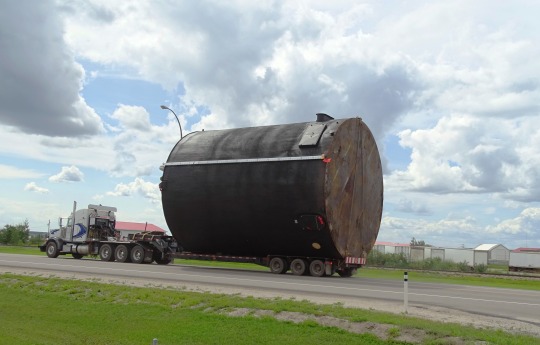
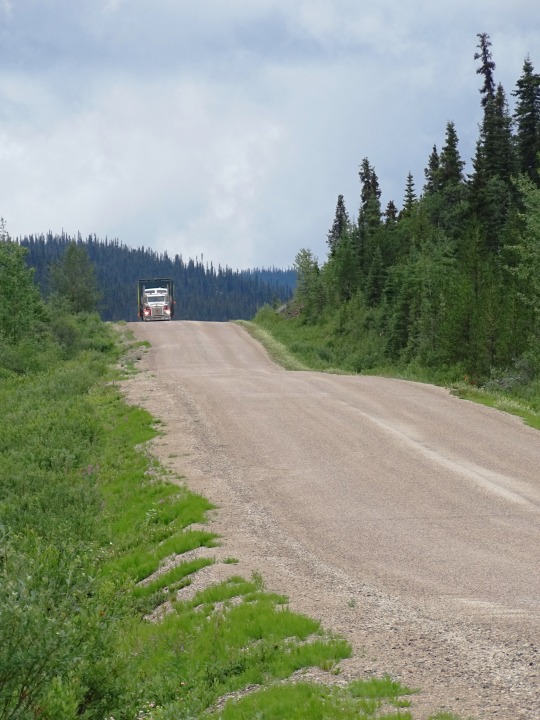

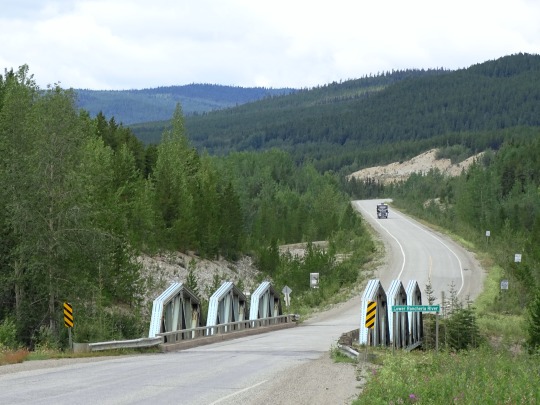
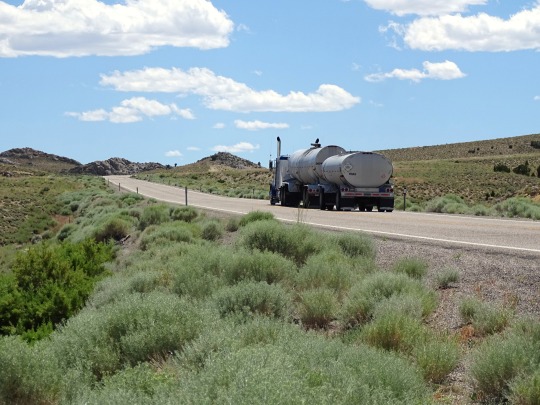
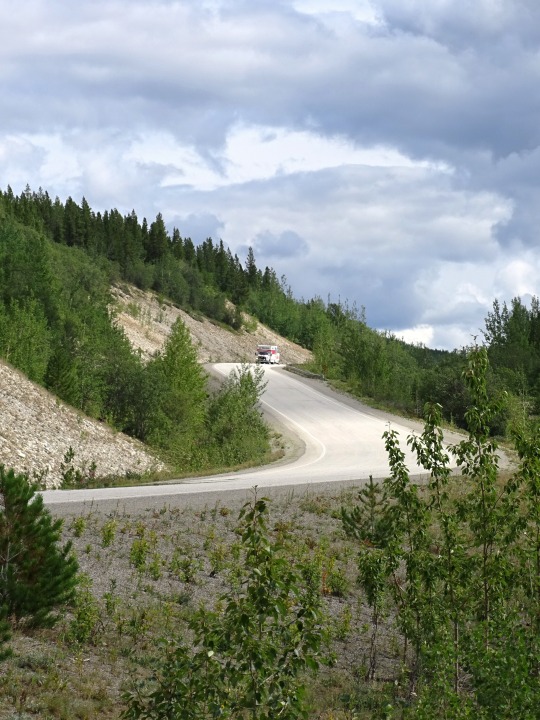
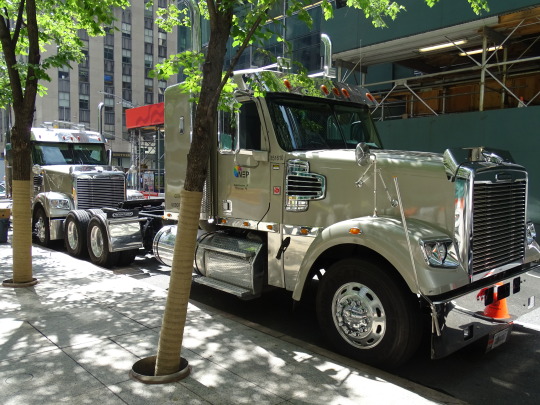

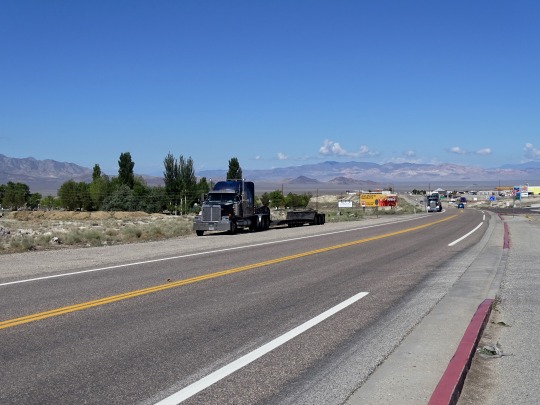
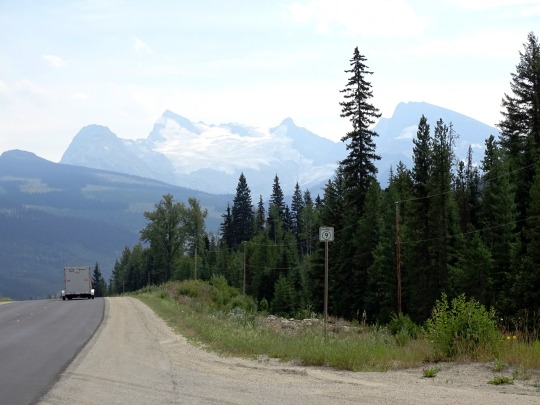

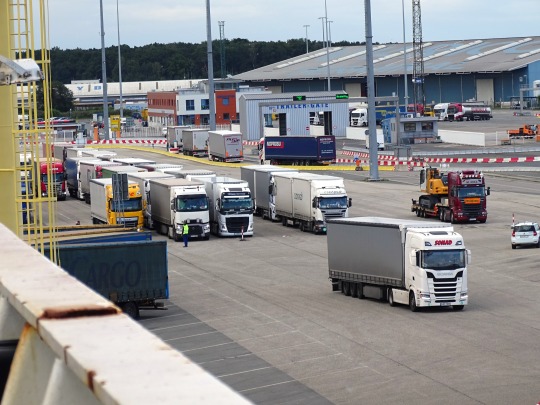
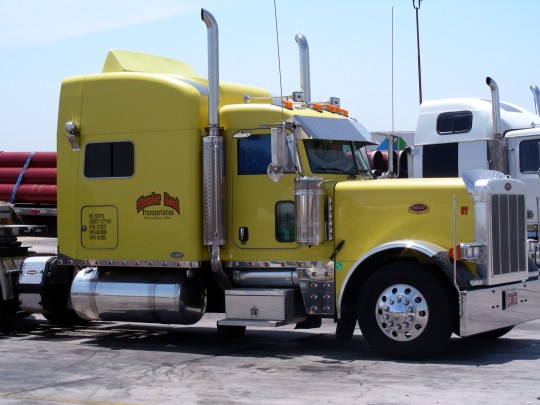

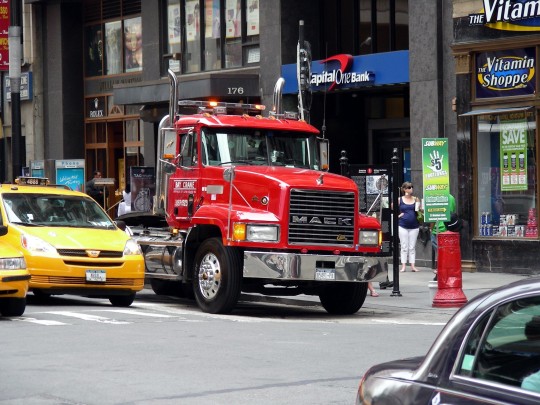

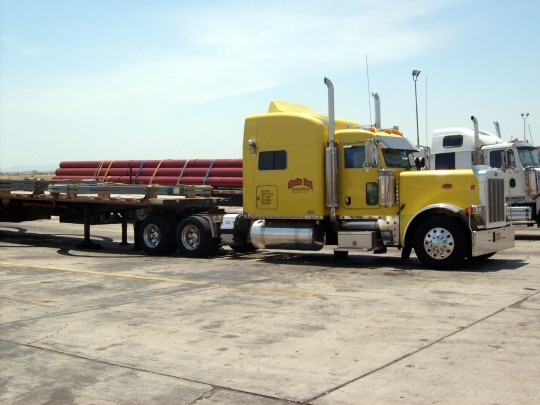
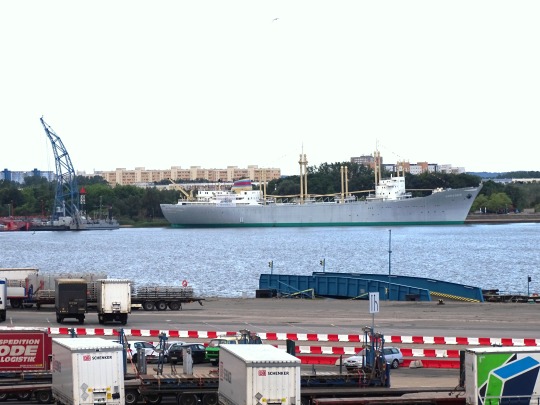
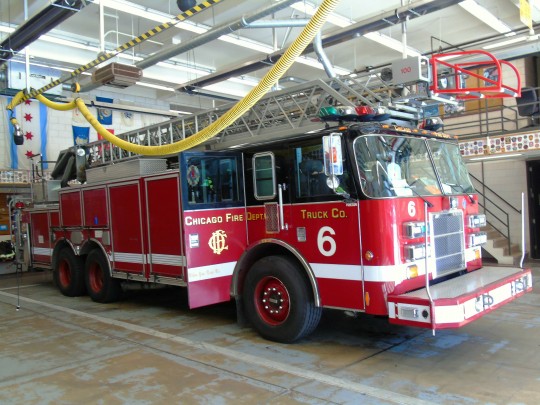
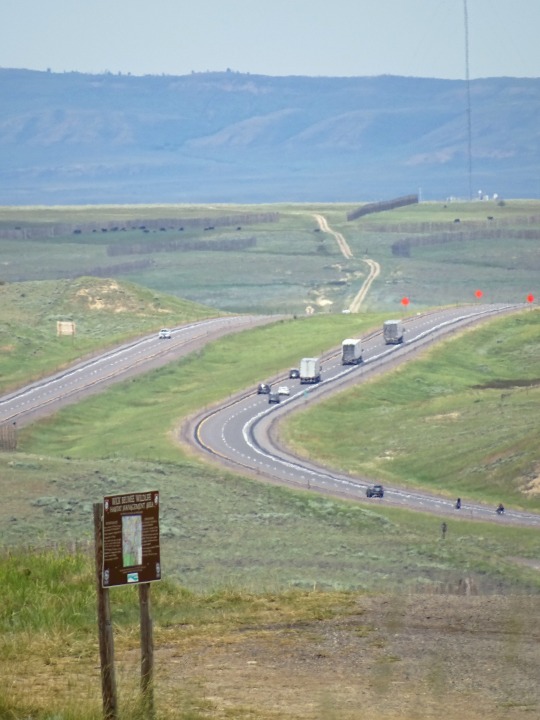



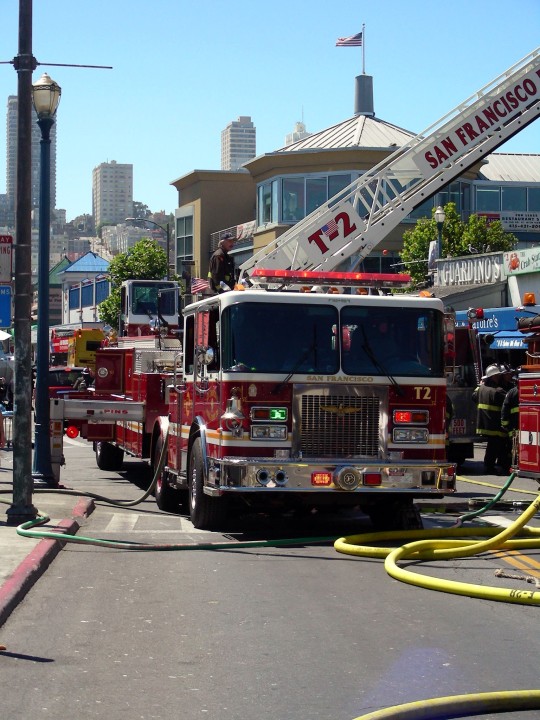




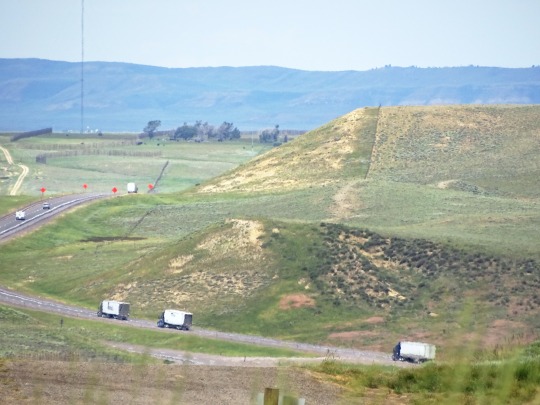
Truck Driver Day
Professional truck drivers are honored and celebrated today with Truck Driver Day. In the United States, a driver is considered to be a truck driver when their vehicle has a gross vehicle weight—the weight of the vehicle loaded—of at least 26,000 pounds. They must obtain a commercial driver's license (CDL) to drive a vehicle of this weight. Employers often require their drivers to take a safety training program, and some also require a high school degree or GED.
Truck drivers carry all kinds of freight—livestock, food, canned goods, liquids, packages, and vehicles—all across the United States and the world. They often have to load and unload their freight and must inspect their trucks before taking to the road. Truck drivers often ship products to stores, and some may have to undertake sales duties. Many truck drivers work long hours. Some may have daily local routes that keep them close to home, while others may have routes and schedules that often change, and many have to be away from home for an extended amount of time.
Some trucks were on the road in the United States prior to World War I. Trucks continued to be used and developed during the war, and by 1920 there were more than a million trucks on the roads of America. Trucking continued to expand over the following decade, on account of advancements such as the introduction of the diesel engine, improved rural roads, the introduction of power brakes and steering, and the standardization of truck and trailer sizes. In the 1930s, a number of trucking regulations were implemented, and the American Trucking Association was created. Trucking activity increased in the 1950s and '60s, in large part because of the creation of the Interstate Highway System. Regulations on the weight of trucks continued to be updated.
The heyday of the truck driver came in the 1960s and '70s. At the time, a wide swath of the public viewed truck drivers as modern-day cowboys or outlaws. The rise of "trucker culture" was signaled with the proliferation of trucker songs and films, the wearing of plaid shirts and trucker hats by the public, and the wide use of CB radios and CB slang. The romanticization of trucker culture subsided by the dawn of the 1980s.
Many truckers went on strike during the energy crises of 1973 and 1979, after the cost of fuel rose. The Motor Carrier Act of 1980 partially deregulated the industry. As a result, many new trucking companies were started. Trucker union membership also drastically declined, leading to lower pay. But the deregulation did reduce consumer costs, and it increased production and competition in the trucking industry. By the twenty-first century, trucking dominated the freight industry. In 2006, there were 26 million trucks on America's roads, which hauled about 70 percent of the country's freight. Truckers continue to play a prominent role in keeping the wheels of the economy turning, and for the hard work they put in to make this happen, they are honored and celebrated today!
How to Observe Truck Driver Day
Some ideas of ways the day could be spent include:
If you are a truck driver, get out there and drive! Or, take the day off. It should be up to you!
Wave to truckers or make a gesture like you are pulling a truck horn in an attempt to get them to honk their horns.
Thank a truck driver. Tell them thanks in person or make a social media post of thanks. Include the hashtag #TruckDriverDay.
Become a truck driver.
Listen to some truck driving songs such as "Convoy" and "Truck Drivin' Man."
Watch some truck driving films such as Smokey and the Bandit, Convoy, and Big Rig.
Talk on a CB radio.
Eat at a truck stop.
Attend or take part in the National Truck Driving Championships, which are held around the time as Truck Driver Day.
Read a book about trucking or truckers such as Trucking Country: The road to America's Wal-Mart Economy or The Long Haul: A Trucker's Tales of Life on the Road.
Explore the websites of organizations and companies related to the industry such as American Trucker, Truckers News, the Federal Motor Carrier Safety Administration, the American Trucking Associations, and the Women in Trucking Association.
#Hafen Rostock#MS Tom Swayer#Trelleborg Harbor#Alaska Highway#Yukon#British Columbia#Canada#Sweden#Germany#summer 2023#Truck Driver Day#TruckDriverDay#12 August#car#truck#streetscene#USA#original photography#I really love the first pic#Nevada#Manhattan#New York City#Sherman Summit#fire truck#Chicago#San Francisco#Echo Canyon#Utah#Wyoming#California
12 notes
·
View notes
Photo

Trelleborg harbor lighthouse found in Sweden and built in 1897 http://www.wikidata.org/entity/Q28375967
0 notes
Text
The Final, Terrible Voyage of the Nautilus
On May 3, 2008, a sunny Saturday in Copenhagen, a crowd gathered along a dock to watch a 58-foot submarine be lowered into the water. Part art project, part engineering feat, the submarine weighed 40 tons and had been built by volunteers at minimal cost from donated iron and other parts. The onlookers cheered as the submarine floated for the first time. Peter Madsen, the designer of the vessel and the organizer of the day’s event, climbed into the hatch, smiling in a white skipper’s hat, before the submarine motored into the water.
Madsen christened the vessel the UC3 Nautilus, after the fictional submarine in Twenty Thousand Leagues Under the Sea. Jules Verne’s antihero Captain Nemo was a figure who lived outside social laws, sailing the seven seas in search of total freedom. Unlike Nemo, Madsen had stayed close to home in Denmark, but he had devoted his life to building audacious vehicles of his own design, ones that might venture high above the atmosphere or down into the depths of the ocean.
Shortly after the launch of the Nautilus, Madsen started another venture. He and a former NASA contractor named Kristian von Bengtson cofounded a company called Copenhagen Suborbitals. Their plan was to launch the first manned built-from-scratch rocket. The two set up shop on Refshaleøen, an area of the city that extends into Copenhagen’s harbor and once had been the heart of Denmark’s shipping empire. That industry’s decline had left empty warehouses and factories, which had been reclaimed by artists, engineers, and other creative types. Madsen and von Bengtson were among them, occupying a hangar, and financing Copenhagen Suborbitals with crowdfunded donations. It was, von Bengtson wrote in 2011 on a WIRED blog he started that year about the rocket building, “the ultimate DIY project.”
The projects made Madsen a kind of antiestablishment celebrity in Denmark. “You had a sense that he was doing something different. It was something bigger. It was something worth being part of,” Robert Fox, a filmmaker who made a 2009 documentary about Madsen called My Private Submarine, told me. A biography of Madsen was published a few years later. Madsen parlayed this fame into speaking engagements.
In 2016, another filmmaker released a documentary called Amateurs in Space, about Madsen and von Bengtson and their efforts to build a rocket. To watch the film is to see the men’s relationship fall apart. In June 2014, Madsen opened a new workshop of his own, Rocket Madsen Space Lab, in a hangar across the paved lot from Copenhagen Suborbitals.
In March 2017, a freelance journalist named Kim Wall learned about the rival rocket makers. Wall had been raised in a Swedish town called Trelleborg, just 40 miles from Copenhagen. She had left home for schooling in Malmö, Sweden, then London, Paris, and eventually New York, which she was calling home for a while. She was in Refshaleøen visiting her partner, Ole Stobbe, a Danish designer who had just moved there. The two were walking around one afternoon, past the vestigial buildings of the old shipyards, when they came across the rocket-building workshops.
In the four years Wall had been a reporter, she had traveled to Haiti to write about practitioners of voodoo; to Sri Lanka to document the tourism on former battlefields of the long civil war; to Cuba to follow the underground network of people delivering TV shows and internet culture. Wall was fascinated with what she called “the undercurrents of rebellion.” Here was just such a story only minutes from where she was staying.
Wall reached out to various publications, and had email exchanges with editors at WIRED, working toward getting an assignment to write about the rocket builders. She and Stobbe had also decided to move to Beijing together, and their departure date was approaching. She had interviewed one of the builders at Copenhagen Suborbitals and was hoping to speak with Madsen, but she hadn’t been able to reach him. She had only a few days left in town.
Wall got the text she had been waiting for: Madsen was inviting her to tea.
On August 10, a Thursday, Wall and Stobbe were preparing to throw a goodbye party. In the late afternoon, just as they were setting up for a barbecue on the quay along the water in Refshaleøen, Wall got the text she had been waiting for: Madsen was inviting her for tea at his workshop. Madsen’s hangar was not far, so she set off. About half an hour later, she returned to let Stobbe know that Madsen had offered to take her out on his submarine. She decided to forgo her own goodbye party for the interview. She asked Stobbe if he wanted to come. Stobbe was “insanely close to saying yes,” he told me, had it not been for the group he had assembled. Because she was going out to sea, Stobbe gave Wall a bigger kiss than he would have had she gone out for, say, ice or lemons. Wall promised to be back in a few hours.
Just before boarding the submarine around 7 pm, Wall texted Stobbe a photo of the Nautilus. A little later, she sent a photo of windmills in the water, and then another of herself at the steering wheel. A while later, Stobbe was tending to a quayside fire when a friend told him to look up. He saw the setting sun and Wall aboard the submarine in the distance, waving toward him.
By most public accounts, Madsen was a charismatic rebel. He had a weathered face with the prominent features of a toy troll. His habitual uniform was coveralls and hiking boots. Fox, the filmmaker, calls him a “modern-day Clumsy Hans,” for the seemingly dimwitted suitor in the Hans Christian Andersen fairy-tale who wins the princess’s favor over his more intelligent brothers. Wall was in the early stages of her reporting, and she would not have known much more about Madsen than what had already been published. It was only later, after everything that happened, that the details of his private life would become important.
Refshaleøen had once been the heart of Denmark’s shipping empire.
Mustafah Abdulaziz
Madsen was born in 1971 and grew up in a small town south of Copenhagen. His mother, Annie, was more than three decades younger than Madsen’s father, Carl—a pub owner. She had three boys from two previous marriages, and the union with Carl did not last long. Madsen was six when his parents split up. Annie moved out with her other sons while Madsen stayed with his aging father.
According to Madsen’s biography, written by Thomas Djursing, Carl was a brutal man who beat his stepsons, though not Madsen. It was Carl who stoked his son’s fascination with rockets, telling him, among other things, about a man who would become a hero to Madsen: Wernher von Braun, the Nazi aerospace engineer who later came to the US and helped develop the Apollo missions. Carl died when Madsen was 18, and for the next few years, Madsen ricocheted around, starting several degrees and apprenticeships—in welding, refrigeration, and engineering—before dropping out of each.
As a teenager, Madsen discovered the Danish Amateur Rocket Club but was eventually kicked out because he wanted to use fuels that others in the group felt weren’t safe. He spent his twenties and thirties organizing his life around the building of submarines and rockets. He often slept at the workshop where he built things.
Madsen’s obsession with submarines and rockets was all-consuming, but not to the exclusion of sex. I got in touch with Camilla Ledegaard Svendsen, an old friend of his, through Facebook. She told me that Madsen became a regular at sexual fetish parties. These were a place of community, she said, “where everyone was relaxed about everything, including their bodies,” and where women felt safe. He also availed himself of Travelgirls.com, a website that advertises meeting “thousands of adventurous girls who want to travel.” Deirdre King, who was Madsen’s close friend for more than a decade, told me he could be doting. “I broke both of my hands once, and Peter came by every day for two months and brushed my hair,” she told me. “He is a man who loves women.”
Fox, who spent 100 days with Madsen and his crew while making My Private Submarine, said that “women found him fascinating” and that the Nautilus sometimes played a role in his seduction strategies. “‘This is my submarine. You want to see my submarine?’ He kind of used to pull that off a lot,” Fox recalled.
After he split from Copenhagen Suborbitals, Madsen moved his rocket-making workshop just across the lot.
Mustafah Abdulaziz
The goodbye party continued into the night that Thursday in August and finally moved to a nearby bar. When Wall still had not returned, Stobbe began to worry. The couple was supposed to leave for a wedding early in the morning, and it was unlike Wall to not stay in touch. Stobbe waited for his partner by the pier. Then he went back to his room, tried to sleep, got up, grabbed his bike, and rode around the island in search of her. Around 1:45 am he called the police; a half hour later he called the navy. Wall was missing.
Just before 4 am, the police were notified of a possible accident by the local maritime rescue center. Soon after, helicopters and ships began searching the waters around Copenhagen. At 10:30 am, the Nautilus was spotted near a lighthouse in Køge Bay, near a desolate stretch of coastline southwest of Refshaleøen. According to a local news report, at 11 am a man out on his boat helping with the search saw Madsen in the submarine tower. He saw Madsen go down the hatch, then reemerge as the sub began to sink.
Madsen then began swimming toward a nearby motor boat, where he was pulled out and turned back to land. By now, newsrooms had learned about the search for a missing submarine. Upon Madsen’s rescue, reporters headed to the dock. When he stepped ashore, a reporter called out to Madsen, asking if everything was OK. Madsen turned around and gave the reporter a thumbs-up. He said he was fine but sad because his Nautilus had sunk. There had been a defect on the ballast tank, he said.
Related Stories
Sarah Scoles
What Happens Now? Studies of Sexual Harassment Can Show the Way
Julia Angwin
How Journalists Fought Back Against Crippling Email Bombs
Issie Lapowsky
The Year Women Reclaimed the Web
Stobbe was at the dock where the press had gathered that morning as Madsen gave his thumbs-up. He knew that something was off and braced for the worst. Still, he wasn’t prepared for what was to come. Later that day the police put out a statement saying that Madsen had told them that he had dropped off Wall on the tip of the island. The police clearly did not believe him; they arrested him and charged him with involuntary manslaughter “for having killed in an unknown way and in an unknown place Kim Isabel Fredrika Wall of Sweden sometime after Thursday 5 pm.”
The next day, a Saturday, Madsen appeared in court at a closed-door session. He hadn’t dropped Wall off on the island; she died in an accident onboard the submarine, he said. His story was changing. A hatch had fallen on her head, and he panicked, he would claim. He said he dragged her body out of the submarine by a rope and “buried her at sea.”
On August 21, a cyclist riding along on Amager Island, not far from where the submarine sank, came across a torso that had washed ashore. The next day, DNA analysis confirmed that the torso belonged to Wall. On September 5, a court approved the prosecutor’s request to change the charge against Madsen to manslaughter. An autopsy later revealed that she had been stabbed 15 times in and around her vagina. Then, one month later, divers found her head, clothing, and a knife in plastic bags, in the waters not far from where her torso was found. They also found both her legs, tied to pieces of metal. Despite these discoveries, Madsen stuck to his story: Wall had hit her head and died, and he disposed of her body, but he denied killing her or dismembering her. Even after divers found a saw that might have been used to dismember Wall’s body, even after the police searched Madsen’s computer and discovered videos that appeared to show women being strangled, decapitated, and tortured—he stuck to his story.
Kim Wall and I were both freelance writers, both young and female, both reporting from abroad. Our friendship began after we followed each other on Instagram and Facebook. Then, a year or so later, in 2016 we found ourselves in New York. We spent most of the summer sitting across from each other in a glum coffee shop in Williamsburg, working on our laptops. We didn’t yet know where reporting ended and living began. We saw in each other a companion, but also a guide. She was my friend and also the closest thing I had to a colleague. When I left for Afghanistan that fall and she for Denmark and later Cuba, we kept in touch by text, talking every week if not more often.
When I learned that Kim had disappeared, my instinct was to find out everything I could about what happened to her. I could say that I was trying to control grief by examining the source of that pain, but that would be reasoning in hindsight. All I knew was that it was painful to think about Kim, and it pained me just a little less to try to report about Madsen.
In the weeks and then months following Kim’s death, I read local news stories, watched the documentaries about Madsen, and scrolled the posts on the blog he kept on an engineering website. I went on Madsen’s Facebook page and sent friend requests to every one of his contacts there. I spoke to dozens of people connected to Madsen—family members, lovers, collaborators, fans, and childhood friends, many of whom would not allow their names to be used for this story. I spoke with lawyers, a forensic pathologist, and an oceanographer. In late September I flew to Copenhagen. I met with members of the police unit leading the investigation, but they did not reveal much and did not want to speak on the record. I ended up giving them a statement. They asked about my friendship with Kim, and I told them what kind of person she was and why it wasn’t surprising that, as a journalist, she would have chosen to go with Madsen on the submarine.
On my first afternoon in Copenhagen, I met with Jens Falkenberg at a restaurant on Dag Hammarskjölds Allé, in an affluent part of town. Falkenberg is a 58-year-old roof salesman. He first heard about Madsen years ago, when he saw a segment about him on television and, by coincidence, met him the next day at a diving shop. He started volunteering at his workshop and helped build the Nautilus. He told me that the police had been calling, asking about a saw that was missing from Madsen’s rocket workshop.
If something did not please Madsen, “he would behave like a child who just lost his toy.”
Falkenberg was like many of the others who volunteered with Madsen, who called himself “a maker of extreme machines.” They spent their weekdays in regular jobs but were weekend builders. They wanted the feeling of community the workshop gave them. At the center of their alternate universe where men built submarines and rockets was Madsen himself.
Some volunteers talked about Madsen as a generous spirit, the kind of guy who would invite a friend who was feeling down “to take part in his little adventures as a means of cheering him up,” as a friend named Lars put it.
Others reexamined old incidents and behaviors. Madsen could swing between rage and euphoria. One volunteer at Copenhagen Suborbitals told me that if something did not please Madsen, “he would behave like a child who just lost his toy or dropped his ice cream or something.” When his mood turned, “most people would know what was going to happen, so they would stay away from him before stuff started flying.” Volunteers said Madsen threw hammers, screwdrivers, and other tools. One volunteer, who asked to be identified by his initials, S. W., helped build the Nautilus. He recalled how Madsen would go from being supportive to “pensive, jubilant, exasperating, and sarcastic.”
“It’s hard for us to understand what drives a madman, because we are not mad,” Falkenberg told me. He then described a recurring joke: Madsen would pretend to be a violent Nazi and would mime hitting Falkenberg, saying “Should I punch you in the kidneys?” or Madsen might joke: “What if I inject battery acid into your veins?”
There was also a lot of joking around about Nazis in the workshop. Crewmembers called each other by Nazi-inspired nicknames. Madsen was called Kaleun, for Kapitänleutnant, a nod to the 1981 film Das Boot, about a fictional German U-boat unit during World War II, Falkenberg said. When they went out in the sub, the crew spoke German, reciting lines from the film.
Madsen’s fascination with space and rockets and technology could hoodwink you into thinking he was a man of the future; you could miss the fact that his obsession was rooted in nostalgia. He was enamored with the early Apollo missions in American space exploration. The reverence he held for the Third Reich was hard to detect as it was framed as irreverence, but it was there. “Some of the way the Nazi regime worked, they did horrible things and they should be executed and everything. But some of the things they did, it worked,” the former workshop volunteer told me. “They built the biggest military machine in just four years. They built it almost out of nothing.”
Building something out of nothing was central to Madsen’s philosophy, as was his belief that he should be able to play by his own rules and control his own destiny. He looked down on people for being cautious. He talked about wanting “to be free from authorities” in making his submarines. After he left Copenhagen Suborbitals, he kept a blog about the progress at Rocket Madsen Space Lab. In one entry from 2015 he described his team as people who “all know that they are taking part in a Peter Madsen project, just like they would do if it was a von Trier movie ... the unqualified belief that Madsens crasy [sic] dreams tend to become reality … makes these people invest time and money.”
Windmills on the water.
Mustafah Abdulaziz
I had been in Copenhagen a week when I went looking for a woman I knew did not want to talk to me. She was a friend and recent sexual partner of Madsen’s. She lived in a converted building in Refshaleøen. One afternoon I walked through its vast hallways until I managed to find her room. I knocked on her door, and she let me in. I had twisted my ankle on the way over and was limping. She let me sit on her carpet and keep my injured foot raised while she ate toast. Her eyes seemed heavy with sleep.
We ended up spending the rest of the day together. She missed a concert; I skipped an appointment. We smoked Bahman cigarettes, an Iranian brand I had brought from Afghanistan. We drank home-brewed kombucha. Music filtered in from another studio down the hall, filling the occasional silence between us.
Like others I spoke with, she said she was enormously angry at Madsen and felt guilty for what she believed he had done. Her pain about Kim’s death seemed deep and genuine. And like others, she was reaching back into her memory of every exchange she had with him in search of clues that might explain this tragedy. She told me that she had either seen or talked to Madsen nearly every day in the weeks leading up to Kim’s death. Then she told me about a particular exchange that was still bothering her.
Wall was early in her career but had already reported stories from Cuba, Haiti, and the Marshall Islands (above) in 2015.
Courtesy of Jan Hendrik Hinzel
Some days before Kim stepped onto the Nautilus, the woman and Madsen were exchanging notes via iMessage. “It was a joke,” she said, pulling out her phone and scrolling through the white and blue texts. Like many people I met in Refshaleøen, this woman was usually occupied with an art project of one kind or another. She had been having trouble finishing a video, and she’d asked Madsen to motivate her with a threat. The conversation began as a casual sexual exchange but quickly escalated. She read the texts to me, translating into English as she went.
“He says he has a murder plan ready in the submarine, and I tell him I am not afraid, you have to be more threatening. He talks about the tools he wants to use, and I say, ‘Oh it’s not threatening.’���” The scenario darkened to inviting a friend to the submarine, where they would suddenly change the mood and begin cutting her up. At the time, the woman didn’t give the exchange much thought; it was not something she took seriously. After a lull in the back and forth, she responded by sending him a video of horses. The moment passed. The police now have the texts.
Kim and I often talked about the challenges of reporting while being young, while being a woman. Harassment, come-ons, and our fear of not being tough enough were perennial concerns. This was especially true on the road. During a reporting trip to Cuba in 2016, Kim texted me to say that as a strategy against unrelenting harassment, she had invented a “fictional NYC fiancé.” The irony of the go-to deflecting move being to proclaim attachment to another man was not lost on us.
Lately I have been thinking about a question Kim posed in a series of texts last spring: 3/14/17, 7:43 am: Kim Wall: i only have questions 3/14/17, 7:43 am: Kim Wall: about agency as a woman 3/14/17, 7:43 am: Kim Wall: and if we will ever be free, no matter what we do 3/14/17, 7:43 am: Kim Wall: (leaning towards no 😔 )
In the days after she disappeared, I heard people ask questions that betrayed a misunderstanding about reporting—couldn’t she have done the interview over the phone?—and casual sexism—why was she there alone so late? On nights when I couldn’t sleep, I would end up on internet chat rooms where the comments sections filled me with rage: “She is a woman—how could she go alone with a man she does not know?” And: “She had skirt and pantyhose—how could she egg on a poor uncle in that way.”
In Afghanistan, where I worked mostly with men, I never wanted to show any sign of weakness or fear. In reporting this story, my editor made me promise that I wouldn’t put myself in harm’s way. But much of reporting is just that—routinely putting yourself in uncomfortable positions. In the four months I spent on this story, I did things that in other circumstances might have seemed foolish. I went on long drives at night with sources. I met strangers on their doorsteps and entered their homes. In stepping onto that submarine, Kim was doing what any reporter onto a good story would have done.
My love for Kim has turned into devotion for her parents and for Ole. I’ve spent time with them in Copenhagen, Trelleborg, and New York when they came for a memorial for Kim; it was held at Columbia University, where she had received her master’s degrees in journalism and international affairs. We talk online and discuss the fund we are setting up in her name. I want to alleviate their suffering, but I also know that the only thing they really want is Kim. (They did not wish to be interviewed for this article, and I understood.)
Ole and I speak on the phone, to talk about grief, and what is to be done about it. He is still moving to China. Movement is good, he says.
Wall and Stobbe stayed in a converted building in Refshaleøen.
Mustafah Abdulaziz
On October 30, the Copenhagen police reported that Madsen had changed his account of that night in August yet again; he said Kim might have died from carbon monoxide poisoning. He also admitted to dismembering her body. Three weeks later, the police found an arm in Køge Bay, weighed down with pipes. Eight days after that, they found another arm. Madsen’s lawyer, Betina Hald Engmark, declined to comment for this story.
I wrote Madsen two letters at Vestre Prison in Copenhagen, where he was being held before trial. I FedExed the first and dropped off the second in a mailbox near the jail. I told him who I was, who Kim had been, my sadness over losing her, and my wish that he would tell me what happened. One afternoon in January, months after I’d returned to New York, I went to pick up my mail and found an envelope with no return address. It was postmarked from Denmark on December 6, 2017, but that didn’t register until after I’d opened it and started scanning the neat, hand-written pages. It was only when I got to the word “submarine” that I realized Madsen had written to me from his detention cell. I remember telling myself to keep breathing as I tried to fold the pages back into the envelope. I did not succeed. The envelope was small and thin and ripped in my hands.
When I finally forced myself to look at the letters—there were three, dated in September and November—I was struck by their terrifying banality. He spoke plainly about the boredom of prison—he had few visitors and few pastimes besides writing. He described seeing Terminator 2 in prison and identifying with the character played by Linda Hamilton. He explained what he had access to (paper and pencil) and what he didn’t have access to (nearly everything else). He also wrote about Kim. He wrote that he thought about Kim every day and that he could “feel her spirit somehow.” There was a disturbing intimacy to his words, as if he were writing to an old friend. He flattered my writing style and invited me to visit. He asked me, “What are you? An explainer trying to understand? A terminator sent to terminate me? ... Without exception—whatever you are—you are welcome, I am all yours.” He ended one of the letters by saying “I will try to get this letter out to you as soon as possible, and hope that you will stay in touch as things gets easyer [sic].”
On January 16, the police released a statement announcing that Madsen was being indicted for homicide that “took place with prior planning and preparation,” and also charged him with “sexual relations other than intercourse of a particularly dangerous nature, as well as for dismemberment.” A week later, the full indictment provided more excruciating details: Madsen had brought onboard “a saw, knife, sharpened screwdrivers, straps, zip ties, and pipes.” Madsen had bound, beaten, and stabbed Kim before killing her, possibly by choking or cutting her throat, the indictment said. Madsen’s lawyer told The New York Times that she was “puzzled” by the indictment. The case is scheduled to go to trial on March 8, with a verdict expected in April. In between is March 23, which would have been Kim’s 31st birthday.
“What are you? An explainer trying to understand? A terminator sent to terminate me?”
The case has been deeply unsettling to people in Denmark, a country of 5.7 million people where there were only 54 reported homicides last year. It is hard for Danes to fathom the grisly discoveries and to imagine that someone as well-known as Madsen could be responsible for them. In December, the Danish publisher Saxo withdrew the first book in a true-crime series about the case, written by Djursing, after it came under criticism.
Before my trip to Denmark, I talked on the phone with a man who had worked with Madsen off and on for nine years. He was in shock. But he also allowed for the possibility of unseen depravity. “Some are walking around with a fantasy like this for maybe 10 years,” he said, “and one day they will do this thing.” Madsen had spent his adulthood pushing against the bounds of society, of reason, of the present, of gravity. Did he think he could get away with committing the ultimate act of cruelty? The trial may provide some answers.
On one of my last days in Copenhagen, I returned to Refshaleøen. I stopped by a restaurant to ask directions to the building where Kim and Ole had lived. The line cook didn’t know the building, so I asked if he knew where the reporter who had died had lived. He cut me off midsentence as I was explaining how I knew Kim and asked, “Why are you doing this?”
I didn’t have a ready answer. I said something about how I wanted to know what had happened. But saying this out loud, to this stranger, I knew I could never really know, could never measure the precise weight of her suffering. Trying to find out what happened to Kim, in hopes of finding meaning in the senselessness of her death, is a selfish act, designed to serve the living. It feels like an act of betrayal.
I still don’t yet know where reporting ends and living begins. All I know is that it hasn’t sunk in yet that she is dead. I’m still wishing for a lesser tragedy: that she was kidnapped but will soon be rescued, or injured but healing somewhere, or lost but will be found. I wish for life. I wish for a different story.
Read More
There's a reason women in tech are finally speaking out
Why female photographers matter now more than ever
How one journalist uses social media to get inside the minds of ISIS
May Jeong (@mayjeong) is a writer and a visiting scholar at the Arthur L. Carter Journalism Institute at New York University.
This article appears in the March issue. Subscribe now.
Additional reporting by Andrea Powell
Related Video
Culture
How a Virtual Reality Journalist Takes Viewers Inside Stories
At Nonny de la Pena's Los Angeles-based Emblematic Group real stories, from melting glaciers to solitary confinement, are made in full virtual reality.
More From this publisher : HERE ; We also Recommend : [wp-stealth-ads rows="2" mobile-rows="2"]
=> *********************************************** Original Post Here: The Final, Terrible Voyage of the Nautilus ************************************ =>
The Final, Terrible Voyage of the Nautilus was originally posted by 23 LI Just News
0 notes
Text
The Final, Terrible Voyage of the Nautilus
On May 3, 2008, a sunny Saturday in Copenhagen, a crowd gathered along a dock to watch a 58-foot submarine be lowered into the water. Part art project, part engineering feat, the submarine weighed 40 tons and had been built by volunteers at minimal cost from donated iron and other parts. The onlookers cheered as the submarine floated for the first time. Peter Madsen, the designer of the vessel and the organizer of the day’s event, climbed into the hatch, smiling in a white skipper’s hat, before the submarine motored into the water.
Madsen christened the vessel the UC3 Nautilus, after the fictional submarine in Twenty Thousand Leagues Under the Sea. Jules Verne’s antihero Captain Nemo was a figure who lived outside social laws, sailing the seven seas in search of total freedom. Unlike Nemo, Madsen had stayed close to home in Denmark, but he had devoted his life to building audacious vehicles of his own design, ones that might venture high above the atmosphere or down into the depths of the ocean.
Shortly after the launch of the Nautilus, Madsen started another venture. He and a former NASA contractor named Kristian von Bengtson cofounded a company called Copenhagen Suborbitals. Their plan was to launch the first manned built-from-scratch rocket. The two set up shop on Refshaleøen, an area of the city that extends into Copenhagen’s harbor and once had been the heart of Denmark’s shipping empire. That industry’s decline had left empty warehouses and factories, which had been reclaimed by artists, engineers, and other creative types. Madsen and von Bengtson were among them, occupying a hangar, and financing Copenhagen Suborbitals with crowdfunded donations. It was, von Bengtson wrote in 2011 on a WIRED blog he started that year about the rocket building, “the ultimate DIY project.”
The projects made Madsen a kind of antiestablishment celebrity in Denmark. “You had a sense that he was doing something different. It was something bigger. It was something worth being part of,” Robert Fox, a filmmaker who made a 2009 documentary about Madsen called My Private Submarine, told me. A biography of Madsen was published a few years later. Madsen parlayed this fame into speaking engagements.
In 2016, another filmmaker released a documentary called Amateurs in Space, about Madsen and von Bengtson and their efforts to build a rocket. To watch the film is to see the men’s relationship fall apart. In June 2014, Madsen opened a new workshop of his own, Rocket Madsen Space Lab, in a hangar across the paved lot from Copenhagen Suborbitals.
In March 2017, a freelance journalist named Kim Wall learned about the rival rocket makers. Wall had been raised in a Swedish town called Trelleborg, just 40 miles from Copenhagen. She had left home for schooling in Malmö, Sweden, then London, Paris, and eventually New York, which she was calling home for a while. She was in Refshaleøen visiting her partner, Ole Stobbe, a Danish designer who had just moved there. The two were walking around one afternoon, past the vestigial buildings of the old shipyards, when they came across the rocket-building workshops.
In the four years Wall had been a reporter, she had traveled to Haiti to write about practitioners of voodoo; to Sri Lanka to document the tourism on former battlefields of the long civil war; to Cuba to follow the underground network of people delivering TV shows and internet culture. Wall was fascinated with what she called “the undercurrents of rebellion.” Here was just such a story only minutes from where she was staying.
Wall reached out to various publications, and had email exchanges with editors at WIRED, working toward getting an assignment to write about the rocket builders. She and Stobbe had also decided to move to Beijing together, and their departure date was approaching. She had interviewed one of the builders at Copenhagen Suborbitals and was hoping to speak with Madsen, but she hadn’t been able to reach him. She had only a few days left in town.
Wall got the text she had been waiting for: Madsen was inviting her to tea.
On August 10, a Thursday, Wall and Stobbe were preparing to throw a goodbye party. In the late afternoon, just as they were setting up for a barbecue on the quay along the water in Refshaleøen, Wall got the text she had been waiting for: Madsen was inviting her for tea at his workshop. Madsen’s hangar was not far, so she set off. About half an hour later, she returned to let Stobbe know that Madsen had offered to take her out on his submarine. She decided to forgo her own goodbye party for the interview. She asked Stobbe if he wanted to come. Stobbe was “insanely close to saying yes,” he told me, had it not been for the group he had assembled. Because she was going out to sea, Stobbe gave Wall a bigger kiss than he would have had she gone out for, say, ice or lemons. Wall promised to be back in a few hours.
Just before boarding the submarine around 7 pm, Wall texted Stobbe a photo of the Nautilus. A little later, she sent a photo of windmills in the water, and then another of herself at the steering wheel. A while later, Stobbe was tending to a quayside fire when a friend told him to look up. He saw the setting sun and Wall aboard the submarine in the distance, waving toward him.
By most public accounts, Madsen was a charismatic rebel. He had a weathered face with the prominent features of a toy troll. His habitual uniform was coveralls and hiking boots. Fox, the filmmaker, calls him a “modern-day Clumsy Hans,” for the seemingly dimwitted suitor in the Hans Christian Andersen fairy-tale who wins the princess’s favor over his more intelligent brothers. Wall was in the early stages of her reporting, and she would not have known much more about Madsen than what had already been published. It was only later, after everything that happened, that the details of his private life would become important.
Refshaleøen had once been the heart of Denmark’s shipping empire.
Mustafah Abdulaziz
Madsen was born in 1971 and grew up in a small town south of Copenhagen. His mother, Annie, was more than three decades younger than Madsen’s father, Carl—a pub owner. She had three boys from two previous marriages, and the union with Carl did not last long. Madsen was six when his parents split up. Annie moved out with her other sons while Madsen stayed with his aging father.
According to Madsen’s biography, written by Thomas Djursing, Carl was a brutal man who beat his stepsons, though not Madsen. It was Carl who stoked his son’s fascination with rockets, telling him, among other things, about a man who would become a hero to Madsen: Wernher von Braun, the Nazi aerospace engineer who later came to the US and helped develop the Apollo missions. Carl died when Madsen was 18, and for the next few years, Madsen ricocheted around, starting several degrees and apprenticeships—in welding, refrigeration, and engineering—before dropping out of each.
As a teenager, Madsen discovered the Danish Amateur Rocket Club but was eventually kicked out because he wanted to use fuels that others in the group felt weren’t safe. He spent his twenties and thirties organizing his life around the building of submarines and rockets. He often slept at the workshop where he built things.
Madsen’s obsession with submarines and rockets was all-consuming, but not to the exclusion of sex. I got in touch with Camilla Ledegaard Svendsen, an old friend of his, through Facebook. She told me that Madsen became a regular at sexual fetish parties. These were a place of community, she said, “where everyone was relaxed about everything, including their bodies,” and where women felt safe. He also availed himself of Travelgirls.com, a website that advertises meeting “thousands of adventurous girls who want to travel.” Deirdre King, who was Madsen’s close friend for more than a decade, told me he could be doting. “I broke both of my hands once, and Peter came by every day for two months and brushed my hair,” she told me. “He is a man who loves women.”
Fox, who spent 100 days with Madsen and his crew while making My Private Submarine, said that “women found him fascinating” and that the Nautilus sometimes played a role in his seduction strategies. “‘This is my submarine. You want to see my submarine?’ He kind of used to pull that off a lot,” Fox recalled.
After he split from Copenhagen Suborbitals, Madsen moved his rocket-making workshop just across the lot.
Mustafah Abdulaziz
The goodbye party continued into the night that Thursday in August and finally moved to a nearby bar. When Wall still had not returned, Stobbe began to worry. The couple was supposed to leave for a wedding early in the morning, and it was unlike Wall to not stay in touch. Stobbe waited for his partner by the pier. Then he went back to his room, tried to sleep, got up, grabbed his bike, and rode around the island in search of her. Around 1:45 am he called the police; a half hour later he called the navy. Wall was missing.
Just before 4 am, the police were notified of a possible accident by the local maritime rescue center. Soon after, helicopters and ships began searching the waters around Copenhagen. At 10:30 am, the Nautilus was spotted near a lighthouse in Køge Bay, near a desolate stretch of coastline southwest of Refshaleøen. According to a local news report, at 11 am a man out on his boat helping with the search saw Madsen in the submarine tower. He saw Madsen go down the hatch, then reemerge as the sub began to sink.
Madsen then began swimming toward a nearby motor boat, where he was pulled out and turned back to land. By now, newsrooms had learned about the search for a missing submarine. Upon Madsen’s rescue, reporters headed to the dock. When he stepped ashore, a reporter called out to Madsen, asking if everything was OK. Madsen turned around and gave the reporter a thumbs-up. He said he was fine but sad because his Nautilus had sunk. There had been a defect on the ballast tank, he said.
Related Stories
Sarah Scoles
What Happens Now? Studies of Sexual Harassment Can Show the Way
Julia Angwin
How Journalists Fought Back Against Crippling Email Bombs
Issie Lapowsky
The Year Women Reclaimed the Web
Stobbe was at the dock where the press had gathered that morning as Madsen gave his thumbs-up. He knew that something was off and braced for the worst. Still, he wasn’t prepared for what was to come. Later that day the police put out a statement saying that Madsen had told them that he had dropped off Wall on the tip of the island. The police clearly did not believe him; they arrested him and charged him with involuntary manslaughter “for having killed in an unknown way and in an unknown place Kim Isabel Fredrika Wall of Sweden sometime after Thursday 5 pm.”
The next day, a Saturday, Madsen appeared in court at a closed-door session. He hadn’t dropped Wall off on the island; she died in an accident onboard the submarine, he said. His story was changing. A hatch had fallen on her head, and he panicked, he would claim. He said he dragged her body out of the submarine by a rope and “buried her at sea.”
On August 21, a cyclist riding along on Amager Island, not far from where the submarine sank, came across a torso that had washed ashore. The next day, DNA analysis confirmed that the torso belonged to Wall. On September 5, a court approved the prosecutor’s request to change the charge against Madsen to manslaughter. An autopsy later revealed that she had been stabbed 15 times in and around her vagina. Then, one month later, divers found her head, clothing, and a knife in plastic bags, in the waters not far from where her torso was found. They also found both her legs, tied to pieces of metal. Despite these discoveries, Madsen stuck to his story: Wall had hit her head and died, and he disposed of her body, but he denied killing her or dismembering her. Even after divers found a saw that might have been used to dismember Wall’s body, even after the police searched Madsen’s computer and discovered videos that appeared to show women being strangled, decapitated, and tortured—he stuck to his story.
Kim Wall and I were both freelance writers, both young and female, both reporting from abroad. Our friendship began after we followed each other on Instagram and Facebook. Then, a year or so later, in 2016 we found ourselves in New York. We spent most of the summer sitting across from each other in a glum coffee shop in Williamsburg, working on our laptops. We didn’t yet know where reporting ended and living began. We saw in each other a companion, but also a guide. She was my friend and also the closest thing I had to a colleague. When I left for Afghanistan that fall and she for Denmark and later Cuba, we kept in touch by text, talking every week if not more often.
When I learned that Kim had disappeared, my instinct was to find out everything I could about what happened to her. I could say that I was trying to control grief by examining the source of that pain, but that would be reasoning in hindsight. All I knew was that it was painful to think about Kim, and it pained me just a little less to try to report about Madsen.
In the weeks and then months following Kim’s death, I read local news stories, watched the documentaries about Madsen, and scrolled the posts on the blog he kept on an engineering website. I went on Madsen’s Facebook page and sent friend requests to every one of his contacts there. I spoke to dozens of people connected to Madsen—family members, lovers, collaborators, fans, and childhood friends, many of whom would not allow their names to be used for this story. I spoke with lawyers, a forensic pathologist, and an oceanographer. In late September I flew to Copenhagen. I met with members of the police unit leading the investigation, but they did not reveal much and did not want to speak on the record. I ended up giving them a statement. They asked about my friendship with Kim, and I told them what kind of person she was and why it wasn’t surprising that, as a journalist, she would have chosen to go with Madsen on the submarine.
On my first afternoon in Copenhagen, I met with Jens Falkenberg at a restaurant on Dag Hammarskjölds Allé, in an affluent part of town. Falkenberg is a 58-year-old roof salesman. He first heard about Madsen years ago, when he saw a segment about him on television and, by coincidence, met him the next day at a diving shop. He started volunteering at his workshop and helped build the Nautilus. He told me that the police had been calling, asking about a saw that was missing from Madsen’s rocket workshop.
If something did not please Madsen, “he would behave like a child who just lost his toy.”
Falkenberg was like many of the others who volunteered with Madsen, who called himself “a maker of extreme machines.” They spent their weekdays in regular jobs but were weekend builders. They wanted the feeling of community the workshop gave them. At the center of their alternate universe where men built submarines and rockets was Madsen himself.
Some volunteers talked about Madsen as a generous spirit, the kind of guy who would invite a friend who was feeling down “to take part in his little adventures as a means of cheering him up,” as a friend named Lars put it.
Others reexamined old incidents and behaviors. Madsen could swing between rage and euphoria. One volunteer at Copenhagen Suborbitals told me that if something did not please Madsen, “he would behave like a child who just lost his toy or dropped his ice cream or something.” When his mood turned, “most people would know what was going to happen, so they would stay away from him before stuff started flying.” Volunteers said Madsen threw hammers, screwdrivers, and other tools. One volunteer, who asked to be identified by his initials, S. W., helped build the Nautilus. He recalled how Madsen would go from being supportive to “pensive, jubilant, exasperating, and sarcastic.”
“It’s hard for us to understand what drives a madman, because we are not mad,” Falkenberg told me. He then described a recurring joke: Madsen would pretend to be a violent Nazi and would mime hitting Falkenberg, saying “Should I punch you in the kidneys?” or Madsen might joke: “What if I inject battery acid into your veins?”
There was also a lot of joking around about Nazis in the workshop. Crewmembers called each other by Nazi-inspired nicknames. Madsen was called Kaleun, for Kapitänleutnant, a nod to the 1981 film Das Boot, about a fictional German U-boat unit during World War II, Falkenberg said. When they went out in the sub, the crew spoke German, reciting lines from the film.
Madsen’s fascination with space and rockets and technology could hoodwink you into thinking he was a man of the future; you could miss the fact that his obsession was rooted in nostalgia. He was enamored with the early Apollo missions in American space exploration. The reverence he held for the Third Reich was hard to detect as it was framed as irreverence, but it was there. “Some of the way the Nazi regime worked, they did horrible things and they should be executed and everything. But some of the things they did, it worked,” the former workshop volunteer told me. “They built the biggest military machine in just four years. They built it almost out of nothing.”
Building something out of nothing was central to Madsen’s philosophy, as was his belief that he should be able to play by his own rules and control his own destiny. He looked down on people for being cautious. He talked about wanting “to be free from authorities” in making his submarines. After he left Copenhagen Suborbitals, he kept a blog about the progress at Rocket Madsen Space Lab. In one entry from 2015 he described his team as people who “all know that they are taking part in a Peter Madsen project, just like they would do if it was a von Trier movie ... the unqualified belief that Madsens crasy [sic] dreams tend to become reality … makes these people invest time and money.”
Windmills on the water.
Mustafah Abdulaziz
I had been in Copenhagen a week when I went looking for a woman I knew did not want to talk to me. She was a friend and recent sexual partner of Madsen’s. She lived in a converted building in Refshaleøen. One afternoon I walked through its vast hallways until I managed to find her room. I knocked on her door, and she let me in. I had twisted my ankle on the way over and was limping. She let me sit on her carpet and keep my injured foot raised while she ate toast. Her eyes seemed heavy with sleep.
We ended up spending the rest of the day together. She missed a concert; I skipped an appointment. We smoked Bahman cigarettes, an Iranian brand I had brought from Afghanistan. We drank home-brewed kombucha. Music filtered in from another studio down the hall, filling the occasional silence between us.
Like others I spoke with, she said she was enormously angry at Madsen and felt guilty for what she believed he had done. Her pain about Kim’s death seemed deep and genuine. And like others, she was reaching back into her memory of every exchange she had with him in search of clues that might explain this tragedy. She told me that she had either seen or talked to Madsen nearly every day in the weeks leading up to Kim’s death. Then she told me about a particular exchange that was still bothering her.
Wall was early in her career but had already reported stories from Cuba, Haiti, and the Marshall Islands (above) in 2015.
Courtesy of Jan Hendrik Hinzel
Some days before Kim stepped onto the Nautilus, the woman and Madsen were exchanging notes via iMessage. “It was a joke,” she said, pulling out her phone and scrolling through the white and blue texts. Like many people I met in Refshaleøen, this woman was usually occupied with an art project of one kind or another. She had been having trouble finishing a video, and she’d asked Madsen to motivate her with a threat. The conversation began as a casual sexual exchange but quickly escalated. She read the texts to me, translating into English as she went.
“He says he has a murder plan ready in the submarine, and I tell him I am not afraid, you have to be more threatening. He talks about the tools he wants to use, and I say, ‘Oh it’s not threatening.’ ” The scenario darkened to inviting a friend to the submarine, where they would suddenly change the mood and begin cutting her up. At the time, the woman didn’t give the exchange much thought; it was not something she took seriously. After a lull in the back and forth, she responded by sending him a video of horses. The moment passed. The police now have the texts.
Kim and I often talked about the challenges of reporting while being young, while being a woman. Harassment, come-ons, and our fear of not being tough enough were perennial concerns. This was especially true on the road. During a reporting trip to Cuba in 2016, Kim texted me to say that as a strategy against unrelenting harassment, she had invented a “fictional NYC fiancé.” The irony of the go-to deflecting move being to proclaim attachment to another man was not lost on us.
Lately I have been thinking about a question Kim posed in a series of texts last spring: 3/14/17, 7:43 am: Kim Wall: i only have questions 3/14/17, 7:43 am: Kim Wall: about agency as a woman 3/14/17, 7:43 am: Kim Wall: and if we will ever be free, no matter what we do 3/14/17, 7:43 am: Kim Wall: (leaning towards no 😔 )
In the days after she disappeared, I heard people ask questions that betrayed a misunderstanding about reporting—couldn’t she have done the interview over the phone?—and casual sexism—why was she there alone so late? On nights when I couldn’t sleep, I would end up on internet chat rooms where the comments sections filled me with rage: “She is a woman—how could she go alone with a man she does not know?” And: “She had skirt and pantyhose—how could she egg on a poor uncle in that way.”
In Afghanistan, where I worked mostly with men, I never wanted to show any sign of weakness or fear. In reporting this story, my editor made me promise that I wouldn’t put myself in harm’s way. But much of reporting is just that—routinely putting yourself in uncomfortable positions. In the four months I spent on this story, I did things that in other circumstances might have seemed foolish. I went on long drives at night with sources. I met strangers on their doorsteps and entered their homes. In stepping onto that submarine, Kim was doing what any reporter onto a good story would have done.
My love for Kim has turned into devotion for her parents and for Ole. I’ve spent time with them in Copenhagen, Trelleborg, and New York when they came for a memorial for Kim; it was held at Columbia University, where she had received her master’s degrees in journalism and international affairs. We talk online and discuss the fund we are setting up in her name. I want to alleviate their suffering, but I also know that the only thing they really want is Kim. (They did not wish to be interviewed for this article, and I understood.)
Ole and I speak on the phone, to talk about grief, and what is to be done about it. He is still moving to China. Movement is good, he says.
Wall and Stobbe stayed in a converted building in Refshaleøen.
Mustafah Abdulaziz
On October 30, the Copenhagen police reported that Madsen had changed his account of that night in August yet again; he said Kim might have died from carbon monoxide poisoning. He also admitted to dismembering her body. Three weeks later, the police found an arm in Køge Bay, weighed down with pipes. Eight days after that, they found another arm. Madsen’s lawyer, Betina Hald Engmark, declined to comment for this story.
I wrote Madsen two letters at Vestre Prison in Copenhagen, where he was being held before trial. I FedExed the first and dropped off the second in a mailbox near the jail. I told him who I was, who Kim had been, my sadness over losing her, and my wish that he would tell me what happened. One afternoon in January, months after I’d returned to New York, I went to pick up my mail and found an envelope with no return address. It was postmarked from Denmark on December 6, 2017, but that didn’t register until after I’d opened it and started scanning the neat, hand-written pages. It was only when I got to the word “submarine” that I realized Madsen had written to me from his detention cell. I remember telling myself to keep breathing as I tried to fold the pages back into the envelope. I did not succeed. The envelope was small and thin and ripped in my hands.
When I finally forced myself to look at the letters—there were three, dated in September and November—I was struck by their terrifying banality. He spoke plainly about the boredom of prison—he had few visitors and few pastimes besides writing. He described seeing Terminator 2 in prison and identifying with the character played by Linda Hamilton. He explained what he had access to (paper and pencil) and what he didn’t have access to (nearly everything else). He also wrote about Kim. He wrote that he thought about Kim every day and that he could “feel her spirit somehow.” There was a disturbing intimacy to his words, as if he were writing to an old friend. He flattered my writing style and invited me to visit. He asked me, “What are you? An explainer trying to understand? A terminator sent to terminate me? ... Without exception—whatever you are—you are welcome, I am all yours.” He ended one of the letters by saying “I will try to get this letter out to you as soon as possible, and hope that you will stay in touch as things gets easyer [sic].”
On January 16, the police released a statement announcing that Madsen was being indicted for homicide that “took place with prior planning and preparation,” and also charged him with “sexual relations other than intercourse of a particularly dangerous nature, as well as for dismemberment.” A week later, the full indictment provided more excruciating details: Madsen had brought onboard “a saw, knife, sharpened screwdrivers, straps, zip ties, and pipes.” Madsen had bound, beaten, and stabbed Kim before killing her, possibly by choking or cutting her throat, the indictment said. Madsen’s lawyer told The New York Times that she was “puzzled” by the indictment. The case is scheduled to go to trial on March 8, with a verdict expected in April. In between is March 23, which would have been Kim’s 31st birthday.
“What are you? An explainer trying to understand? A terminator sent to terminate me?”
The case has been deeply unsettling to people in Denmark, a country of 5.7 million people where there were only 54 reported homicides last year. It is hard for Danes to fathom the grisly discoveries and to imagine that someone as well-known as Madsen could be responsible for them. In December, the Danish publisher Saxo withdrew the first book in a true-crime series about the case, written by Djursing, after it came under criticism.
Before my trip to Denmark, I talked on the phone with a man who had worked with Madsen off and on for nine years. He was in shock. But he also allowed for the possibility of unseen depravity. “Some are walking around with a fantasy like this for maybe 10 years,” he said, “and one day they will do this thing.” Madsen had spent his adulthood pushing against the bounds of society, of reason, of the present, of gravity. Did he think he could get away with committing the ultimate act of cruelty? The trial may provide some answers.
On one of my last days in Copenhagen, I returned to Refshaleøen. I stopped by a restaurant to ask directions to the building where Kim and Ole had lived. The line cook didn’t know the building, so I asked if he knew where the reporter who had died had lived. He cut me off midsentence as I was explaining how I knew Kim and asked, “Why are you doing this?”
I didn’t have a ready answer. I said something about how I wanted to know what had happened. But saying this out loud, to this stranger, I knew I could never really know, could never measure the precise weight of her suffering. Trying to find out what happened to Kim, in hopes of finding meaning in the senselessness of her death, is a selfish act, designed to serve the living. It feels like an act of betrayal.
I still don’t yet know where reporting ends and living begins. All I know is that it hasn’t sunk in yet that she is dead. I’m still wishing for a lesser tragedy: that she was kidnapped but will soon be rescued, or injured but healing somewhere, or lost but will be found. I wish for life. I wish for a different story.
Read More
There's a reason women in tech are finally speaking out
Why female photographers matter now more than ever
How one journalist uses social media to get inside the minds of ISIS
May Jeong (@mayjeong) is a writer and a visiting scholar at the Arthur L. Carter Journalism Institute at New York University.
This article appears in the March issue. Subscribe now.
Additional reporting by Andrea Powell
Related Video
Culture
How a Virtual Reality Journalist Takes Viewers Inside Stories
At Nonny de la Pena's Los Angeles-based Emblematic Group real stories, from melting glaciers to solitary confinement, are made in full virtual reality.
More From this publisher : HERE ; This post was curated using : TrendingTraffic
=> *********************************************** See More Here: The Final, Terrible Voyage of the Nautilus ************************************ =>
The Final, Terrible Voyage of the Nautilus was originally posted by 9 IV FanZone News
0 notes
Text
The Final, Terrible Voyage of the Nautilus
On May 3, 2008, a sunny Saturday in Copenhagen, a crowd gathered along a dock to watch a 58-foot submarine be lowered into the water. Part art project, part engineering feat, the submarine weighed 40 tons and had been built by volunteers at minimal cost from donated iron and other parts. The onlookers cheered as the submarine floated for the first time. Peter Madsen, the designer of the vessel and the organizer of the day’s event, climbed into the hatch, smiling in a white skipper’s hat, before the submarine motored into the water.
Madsen christened the vessel the UC3 Nautilus, after the fictional submarine in Twenty Thousand Leagues Under the Sea. Jules Verne’s antihero Captain Nemo was a figure who lived outside social laws, sailing the seven seas in search of total freedom. Unlike Nemo, Madsen had stayed close to home in Denmark, but he had devoted his life to building audacious vehicles of his own design, ones that might venture high above the atmosphere or down into the depths of the ocean.
Shortly after the launch of the Nautilus, Madsen started another venture. He and a former NASA contractor named Kristian von Bengtson cofounded a company called Copenhagen Suborbitals. Their plan was to launch the first manned built-from-scratch rocket. The two set up shop on Refshaleøen, an area of the city that extends into Copenhagen’s harbor and once had been the heart of Denmark’s shipping empire. That industry’s decline had left empty warehouses and factories, which had been reclaimed by artists, engineers, and other creative types. Madsen and von Bengtson were among them, occupying a hangar, and financing Copenhagen Suborbitals with crowdfunded donations. It was, von Bengtson wrote in 2011 on a WIRED blog he started that year about the rocket building, “the ultimate DIY project.”
The projects made Madsen a kind of antiestablishment celebrity in Denmark. “You had a sense that he was doing something different. It was something bigger. It was something worth being part of,” Robert Fox, a filmmaker who made a 2009 documentary about Madsen called My Private Submarine, told me. A biography of Madsen was published a few years later. Madsen parlayed this fame into speaking engagements.
In 2016, another filmmaker released a documentary called Amateurs in Space, about Madsen and von Bengtson and their efforts to build a rocket. To watch the film is to see the men’s relationship fall apart. In June 2014, Madsen opened a new workshop of his own, Rocket Madsen Space Lab, in a hangar across the paved lot from Copenhagen Suborbitals.
In March 2017, a freelance journalist named Kim Wall learned about the rival rocket makers. Wall had been raised in a Swedish town called Trelleborg, just 40 miles from Copenhagen. She had left home for schooling in Malmö, Sweden, then London, Paris, and eventually New York, which she was calling home for a while. She was in Refshaleøen visiting her partner, Ole Stobbe, a Danish designer who had just moved there. The two were walking around one afternoon, past the vestigial buildings of the old shipyards, when they came across the rocket-building workshops.
In the four years Wall had been a reporter, she had traveled to Haiti to write about practitioners of voodoo; to Sri Lanka to document the tourism on former battlefields of the long civil war; to Cuba to follow the underground network of people delivering TV shows and internet culture. Wall was fascinated with what she called “the undercurrents of rebellion.” Here was just such a story only minutes from where she was staying.
Wall reached out to various publications, and had email exchanges with editors at WIRED, working toward getting an assignment to write about the rocket builders. She and Stobbe had also decided to move to Beijing together, and their departure date was approaching. She had interviewed one of the builders at Copenhagen Suborbitals and was hoping to speak with Madsen, but she hadn’t been able to reach him. She had only a few days left in town.
Wall got the text she had been waiting for: Madsen was inviting her to tea.
On August 10, a Thursday, Wall and Stobbe were preparing to throw a goodbye party. In the late afternoon, just as they were setting up for a barbecue on the quay along the water in Refshaleøen, Wall got the text she had been waiting for: Madsen was inviting her for tea at his workshop. Madsen’s hangar was not far, so she set off. About half an hour later, she returned to let Stobbe know that Madsen had offered to take her out on his submarine. She decided to forgo her own goodbye party for the interview. She asked Stobbe if he wanted to come. Stobbe was “insanely close to saying yes,” he told me, had it not been for the group he had assembled. Because she was going out to sea, Stobbe gave Wall a bigger kiss than he would have had she gone out for, say, ice or lemons. Wall promised to be back in a few hours.
Just before boarding the submarine around 7 pm, Wall texted Stobbe a photo of the Nautilus. A little later, she sent a photo of windmills in the water, and then another of herself at the steering wheel. A while later, Stobbe was tending to a quayside fire when a friend told him to look up. He saw the setting sun and Wall aboard the submarine in the distance, waving toward him.
By most public accounts, Madsen was a charismatic rebel. He had a weathered face with the prominent features of a toy troll. His habitual uniform was coveralls and hiking boots. Fox, the filmmaker, calls him a “modern-day Clumsy Hans,” for the seemingly dimwitted suitor in the Hans Christian Andersen fairy-tale who wins the princess’s favor over his more intelligent brothers. Wall was in the early stages of her reporting, and she would not have known much more about Madsen than what had already been published. It was only later, after everything that happened, that the details of his private life would become important.
Refshaleøen had once been the heart of Denmark’s shipping empire.
Mustafah Abdulaziz
Madsen was born in 1971 and grew up in a small town south of Copenhagen. His mother, Annie, was more than three decades younger than Madsen’s father, Carl—a pub owner. She had three boys from two previous marriages, and the union with Carl did not last long. Madsen was six when his parents split up. Annie moved out with her other sons while Madsen stayed with his aging father.
According to Madsen’s biography, written by Thomas Djursing, Carl was a brutal man who beat his stepsons, though not Madsen. It was Carl who stoked his son’s fascination with rockets, telling him, among other things, about a man who would become a hero to Madsen: Wernher von Braun, the Nazi aerospace engineer who later came to the US and helped develop the Apollo missions. Carl died when Madsen was 18, and for the next few years, Madsen ricocheted around, starting several degrees and apprenticeships—in welding, refrigeration, and engineering—before dropping out of each.
As a teenager, Madsen discovered the Danish Amateur Rocket Club but was eventually kicked out because he wanted to use fuels that others in the group felt weren’t safe. He spent his twenties and thirties organizing his life around the building of submarines and rockets. He often slept at the workshop where he built things.
Madsen’s obsession with submarines and rockets was all-consuming, but not to the exclusion of sex. I got in touch with Camilla Ledegaard Svendsen, an old friend of his, through Facebook. She told me that Madsen became a regular at sexual fetish parties. These were a place of community, she said, “where everyone was relaxed about everything, including their bodies,” and where women felt safe. He also availed himself of Travelgirls.com, a website that advertises meeting “thousands of adventurous girls who want to travel.” Deirdre King, who was Madsen’s close friend for more than a decade, told me he could be doting. “I broke both of my hands once, and Peter came by every day for two months and brushed my hair,” she told me. “He is a man who loves women.”
Fox, who spent 100 days with Madsen and his crew while making My Private Submarine, said that “women found him fascinating” and that the Nautilus sometimes played a role in his seduction strategies. “‘This is my submarine. You want to see my submarine?’ He kind of used to pull that off a lot,” Fox recalled.
After he split from Copenhagen Suborbitals, Madsen moved his rocket-making workshop just across the lot.
Mustafah Abdulaziz
The goodbye party continued into the night that Thursday in August and finally moved to a nearby bar. When Wall still had not returned, Stobbe began to worry. The couple was supposed to leave for a wedding early in the morning, and it was unlike Wall to not stay in touch. Stobbe waited for his partner by the pier. Then he went back to his room, tried to sleep, got up, grabbed his bike, and rode around the island in search of her. Around 1:45 am he called the police; a half hour later he called the navy. Wall was missing.
Just before 4 am, the police were notified of a possible accident by the local maritime rescue center. Soon after, helicopters and ships began searching the waters around Copenhagen. At 10:30 am, the Nautilus was spotted near a lighthouse in Køge Bay, near a desolate stretch of coastline southwest of Refshaleøen. According to a local news report, at 11 am a man out on his boat helping with the search saw Madsen in the submarine tower. He saw Madsen go down the hatch, then reemerge as the sub began to sink.
Madsen then began swimming toward a nearby motor boat, where he was pulled out and turned back to land. By now, newsrooms had learned about the search for a missing submarine. Upon Madsen’s rescue, reporters headed to the dock. When he stepped ashore, a reporter called out to Madsen, asking if everything was OK. Madsen turned around and gave the reporter a thumbs-up. He said he was fine but sad because his Nautilus had sunk. There had been a defect on the ballast tank, he said.
Related Stories
Sarah Scoles
What Happens Now? Studies of Sexual Harassment Can Show the Way
Julia Angwin
How Journalists Fought Back Against Crippling Email Bombs
Issie Lapowsky
The Year Women Reclaimed the Web
Stobbe was at the dock where the press had gathered that morning as Madsen gave his thumbs-up. He knew that something was off and braced for the worst. Still, he wasn’t prepared for what was to come. Later that day the police put out a statement saying that Madsen had told them that he had dropped off Wall on the tip of the island. The police clearly did not believe him; they arrested him and charged him with involuntary manslaughter “for having killed in an unknown way and in an unknown place Kim Isabel Fredrika Wall of Sweden sometime after Thursday 5 pm.”
The next day, a Saturday, Madsen appeared in court at a closed-door session. He hadn’t dropped Wall off on the island; she died in an accident onboard the submarine, he said. His story was changing. A hatch had fallen on her head, and he panicked, he would claim. He said he dragged her body out of the submarine by a rope and “buried her at sea.”
On August 21, a cyclist riding along on Amager Island, not far from where the submarine sank, came across a torso that had washed ashore. The next day, DNA analysis confirmed that the torso belonged to Wall. On September 5, a court approved the prosecutor’s request to change the charge against Madsen to manslaughter. An autopsy later revealed that she had been stabbed 15 times in and around her vagina. Then, one month later, divers found her head, clothing, and a knife in plastic bags, in the waters not far from where her torso was found. They also found both her legs, tied to pieces of metal. Despite these discoveries, Madsen stuck to his story: Wall had hit her head and died, and he disposed of her body, but he denied killing her or dismembering her. Even after divers found a saw that might have been used to dismember Wall’s body, even after the police searched Madsen’s computer and discovered videos that appeared to show women being strangled, decapitated, and tortured—he stuck to his story.
Kim Wall and I were both freelance writers, both young and female, both reporting from abroad. Our friendship began after we followed each other on Instagram and Facebook. Then, a year or so later, in 2016 we found ourselves in New York. We spent most of the summer sitting across from each other in a glum coffee shop in Williamsburg, working on our laptops. We didn’t yet know where reporting ended and living began. We saw in each other a companion, but also a guide. She was my friend and also the closest thing I had to a colleague. When I left for Afghanistan that fall and she for Denmark and later Cuba, we kept in touch by text, talking every week if not more often.
When I learned that Kim had disappeared, my instinct was to find out everything I could about what happened to her. I could say that I was trying to control grief by examining the source of that pain, but that would be reasoning in hindsight. All I knew was that it was painful to think about Kim, and it pained me just a little less to try to report about Madsen.
In the weeks and then months following Kim’s death, I read local news stories, watched the documentaries about Madsen, and scrolled the posts on the blog he kept on an engineering website. I went on Madsen’s Facebook page and sent friend requests to every one of his contacts there. I spoke to dozens of people connected to Madsen—family members, lovers, collaborators, fans, and childhood friends, many of whom would not allow their names to be used for this story. I spoke with lawyers, a forensic pathologist, and an oceanographer. In late September I flew to Copenhagen. I met with members of the police unit leading the investigation, but they did not reveal much and did not want to speak on the record. I ended up giving them a statement. They asked about my friendship with Kim, and I told them what kind of person she was and why it wasn’t surprising that, as a journalist, she would have chosen to go with Madsen on the submarine.
On my first afternoon in Copenhagen, I met with Jens Falkenberg at a restaurant on Dag Hammarskjölds Allé, in an affluent part of town. Falkenberg is a 58-year-old roof salesman. He first heard about Madsen years ago, when he saw a segment about him on television and, by coincidence, met him the next day at a diving shop. He started volunteering at his workshop and helped build the Nautilus. He told me that the police had been calling, asking about a saw that was missing from Madsen’s rocket workshop.
If something did not please Madsen, “he would behave like a child who just lost his toy.”
Falkenberg was like many of the others who volunteered with Madsen, who called himself “a maker of extreme machines.” They spent their weekdays in regular jobs but were weekend builders. They wanted the feeling of community the workshop gave them. At the center of their alternate universe where men built submarines and rockets was Madsen himself.
Some volunteers talked about Madsen as a generous spirit, the kind of guy who would invite a friend who was feeling down “to take part in his little adventures as a means of cheering him up,” as a friend named Lars put it.
Others reexamined old incidents and behaviors. Madsen could swing between rage and euphoria. One volunteer at Copenhagen Suborbitals told me that if something did not please Madsen, “he would behave like a child who just lost his toy or dropped his ice cream or something.” When his mood turned, “most people would know what was going to happen, so they would stay away from him before stuff started flying.” Volunteers said Madsen threw hammers, screwdrivers, and other tools. One volunteer, who asked to be identified by his initials, S. W., helped build the Nautilus. He recalled how Madsen would go from being supportive to “pensive, jubilant, exasperating, and sarcastic.”
“It’s hard for us to understand what drives a madman, because we are not mad,” Falkenberg told me. He then described a recurring joke: Madsen would pretend to be a violent Nazi and would mime hitting Falkenberg, saying “Should I punch you in the kidneys?” or Madsen might joke: “What if I inject battery acid into your veins?”
There was also a lot of joking around about Nazis in the workshop. Crewmembers called each other by Nazi-inspired nicknames. Madsen was called Kaleun, for Kapitänleutnant, a nod to the 1981 film Das Boot, about a fictional German U-boat unit during World War II, Falkenberg said. When they went out in the sub, the crew spoke German, reciting lines from the film.
Madsen’s fascination with space and rockets and technology could hoodwink you into thinking he was a man of the future; you could miss the fact that his obsession was rooted in nostalgia. He was enamored with the early Apollo missions in American space exploration. The reverence he held for the Third Reich was hard to detect as it was framed as irreverence, but it was there. “Some of the way the Nazi regime worked, they did horrible things and they should be executed and everything. But some of the things they did, it worked,” the former workshop volunteer told me. “They built the biggest military machine in just four years. They built it almost out of nothing.”
Building something out of nothing was central to Madsen��s philosophy, as was his belief that he should be able to play by his own rules and control his own destiny. He looked down on people for being cautious. He talked about wanting “to be free from authorities” in making his submarines. After he left Copenhagen Suborbitals, he kept a blog about the progress at Rocket Madsen Space Lab. In one entry from 2015 he described his team as people who “all know that they are taking part in a Peter Madsen project, just like they would do if it was a von Trier movie ... the unqualified belief that Madsens crasy [sic] dreams tend to become reality … makes these people invest time and money.”
Windmills on the water.
Mustafah Abdulaziz
I had been in Copenhagen a week when I went looking for a woman I knew did not want to talk to me. She was a friend and recent sexual partner of Madsen’s. She lived in a converted building in Refshaleøen. One afternoon I walked through its vast hallways until I managed to find her room. I knocked on her door, and she let me in. I had twisted my ankle on the way over and was limping. She let me sit on her carpet and keep my injured foot raised while she ate toast. Her eyes seemed heavy with sleep.
We ended up spending the rest of the day together. She missed a concert; I skipped an appointment. We smoked Bahman cigarettes, an Iranian brand I had brought from Afghanistan. We drank home-brewed kombucha. Music filtered in from another studio down the hall, filling the occasional silence between us.
Like others I spoke with, she said she was enormously angry at Madsen and felt guilty for what she believed he had done. Her pain about Kim’s death seemed deep and genuine. And like others, she was reaching back into her memory of every exchange she had with him in search of clues that might explain this tragedy. She told me that she had either seen or talked to Madsen nearly every day in the weeks leading up to Kim’s death. Then she told me about a particular exchange that was still bothering her.
Wall was early in her career but had already reported stories from Cuba, Haiti, and the Marshall Islands (above) in 2015.
Courtesy of Jan Hendrik Hinzel
Some days before Kim stepped onto the Nautilus, the woman and Madsen were exchanging notes via iMessage. “It was a joke,” she said, pulling out her phone and scrolling through the white and blue texts. Like many people I met in Refshaleøen, this woman was usually occupied with an art project of one kind or another. She had been having trouble finishing a video, and she’d asked Madsen to motivate her with a threat. The conversation began as a casual sexual exchange but quickly escalated. She read the texts to me, translating into English as she went.
“He says he has a murder plan ready in the submarine, and I tell him I am not afraid, you have to be more threatening. He talks about the tools he wants to use, and I say, ‘Oh it’s not threatening.’ ” The scenario darkened to inviting a friend to the submarine, where they would suddenly change the mood and begin cutting her up. At the time, the woman didn’t give the exchange much thought; it was not something she took seriously. After a lull in the back and forth, she responded by sending him a video of horses. The moment passed. The police now have the texts.
Kim and I often talked about the challenges of reporting while being young, while being a woman. Harassment, come-ons, and our fear of not being tough enough were perennial concerns. This was especially true on the road. During a reporting trip to Cuba in 2016, Kim texted me to say that as a strategy against unrelenting harassment, she had invented a “fictional NYC fiancé.” The irony of the go-to deflecting move being to proclaim attachment to another man was not lost on us.
Lately I have been thinking about a question Kim posed in a series of texts last spring: 3/14/17, 7:43 am: Kim Wall: i only have questions 3/14/17, 7:43 am: Kim Wall: about agency as a woman 3/14/17, 7:43 am: Kim Wall: and if we will ever be free, no matter what we do 3/14/17, 7:43 am: Kim Wall: (leaning towards no 😔 )
In the days after she disappeared, I heard people ask questions that betrayed a misunderstanding about reporting—couldn’t she have done the interview over the phone?—and casual sexism—why was she there alone so late? On nights when I couldn’t sleep, I would end up on internet chat rooms where the comments sections filled me with rage: “She is a woman—how could she go alone with a man she does not know?” And: “She had skirt and pantyhose—how could she egg on a poor uncle in that way.”
In Afghanistan, where I worked mostly with men, I never wanted to show any sign of weakness or fear. In reporting this story, my editor made me promise that I wouldn’t put myself in harm’s way. But much of reporting is just that—routinely putting yourself in uncomfortable positions. In the four months I spent on this story, I did things that in other circumstances might have seemed foolish. I went on long drives at night with sources. I met strangers on their doorsteps and entered their homes. In stepping onto that submarine, Kim was doing what any reporter onto a good story would have done.
My love for Kim has turned into devotion for her parents and for Ole. I’ve spent time with them in Copenhagen, Trelleborg, and New York when they came for a memorial for Kim; it was held at Columbia University, where she had received her master’s degrees in journalism and international affairs. We talk online and discuss the fund we are setting up in her name. I want to alleviate their suffering, but I also know that the only thing they really want is Kim. (They did not wish to be interviewed for this article, and I understood.)
Ole and I speak on the phone, to talk about grief, and what is to be done about it. He is still moving to China. Movement is good, he says.
Wall and Stobbe stayed in a converted building in Refshaleøen.
Mustafah Abdulaziz
On October 30, the Copenhagen police reported that Madsen had changed his account of that night in August yet again; he said Kim might have died from carbon monoxide poisoning. He also admitted to dismembering her body. Three weeks later, the police found an arm in Køge Bay, weighed down with pipes. Eight days after that, they found another arm. Madsen’s lawyer, Betina Hald Engmark, declined to comment for this story.
I wrote Madsen two letters at Vestre Prison in Copenhagen, where he was being held before trial. I FedExed the first and dropped off the second in a mailbox near the jail. I told him who I was, who Kim had been, my sadness over losing her, and my wish that he would tell me what happened. One afternoon in January, months after I’d returned to New York, I went to pick up my mail and found an envelope with no return address. It was postmarked from Denmark on December 6, 2017, but that didn’t register until after I’d opened it and started scanning the neat, hand-written pages. It was only when I got to the word “submarine” that I realized Madsen had written to me from his detention cell. I remember telling myself to keep breathing as I tried to fold the pages back into the envelope. I did not succeed. The envelope was small and thin and ripped in my hands.
When I finally forced myself to look at the letters—there were three, dated in September and November—I was struck by their terrifying banality. He spoke plainly about the boredom of prison—he had few visitors and few pastimes besides writing. He described seeing Terminator 2 in prison and identifying with the character played by Linda Hamilton. He explained what he had access to (paper and pencil) and what he didn’t have access to (nearly everything else). He also wrote about Kim. He wrote that he thought about Kim every day and that he could “feel her spirit somehow.” There was a disturbing intimacy to his words, as if he were writing to an old friend. He flattered my writing style and invited me to visit. He asked me, “What are you? An explainer trying to understand? A terminator sent to terminate me? ... Without exception—whatever you are—you are welcome, I am all yours.” He ended one of the letters by saying “I will try to get this letter out to you as soon as possible, and hope that you will stay in touch as things gets easyer [sic].”
On January 16, the police released a statement announcing that Madsen was being indicted for homicide that “took place with prior planning and preparation,” and also charged him with “sexual relations other than intercourse of a particularly dangerous nature, as well as for dismemberment.” A week later, the full indictment provided more excruciating details: Madsen had brought onboard “a saw, knife, sharpened screwdrivers, straps, zip ties, and pipes.” Madsen had bound, beaten, and stabbed Kim before killing her, possibly by choking or cutting her throat, the indictment said. Madsen’s lawyer told The New York Times that she was “puzzled” by the indictment. The case is scheduled to go to trial on March 8, with a verdict expected in April. In between is March 23, which would have been Kim’s 31st birthday.
“What are you? An explainer trying to understand? A terminator sent to terminate me?”
The case has been deeply unsettling to people in Denmark, a country of 5.7 million people where there were only 54 reported homicides last year. It is hard for Danes to fathom the grisly discoveries and to imagine that someone as well-known as Madsen could be responsible for them. In December, the Danish publisher Saxo withdrew the first book in a true-crime series about the case, written by Djursing, after it came under criticism.
Before my trip to Denmark, I talked on the phone with a man who had worked with Madsen off and on for nine years. He was in shock. But he also allowed for the possibility of unseen depravity. “Some are walking around with a fantasy like this for maybe 10 years,” he said, “and one day they will do this thing.” Madsen had spent his adulthood pushing against the bounds of society, of reason, of the present, of gravity. Did he think he could get away with committing the ultimate act of cruelty? The trial may provide some answers.
On one of my last days in Copenhagen, I returned to Refshaleøen. I stopped by a restaurant to ask directions to the building where Kim and Ole had lived. The line cook didn’t know the building, so I asked if he knew where the reporter who had died had lived. He cut me off midsentence as I was explaining how I knew Kim and asked, “Why are you doing this?”
I didn’t have a ready answer. I said something about how I wanted to know what had happened. But saying this out loud, to this stranger, I knew I could never really know, could never measure the precise weight of her suffering. Trying to find out what happened to Kim, in hopes of finding meaning in the senselessness of her death, is a selfish act, designed to serve the living. It feels like an act of betrayal.
I still don’t yet know where reporting ends and living begins. All I know is that it hasn’t sunk in yet that she is dead. I’m still wishing for a lesser tragedy: that she was kidnapped but will soon be rescued, or injured but healing somewhere, or lost but will be found. I wish for life. I wish for a different story.
Read More
There's a reason women in tech are finally speaking out
Why female photographers matter now more than ever
How one journalist uses social media to get inside the minds of ISIS
May Jeong (@mayjeong) is a writer and a visiting scholar at the Arthur L. Carter Journalism Institute at New York University.
This article appears in the March issue. Subscribe now.
Additional reporting by Andrea Powell
Related Video
Culture
How a Virtual Reality Journalist Takes Viewers Inside Stories
At Nonny de la Pena's Los Angeles-based Emblematic Group real stories, from melting glaciers to solitary confinement, are made in full virtual reality.
More From this publisher : HERE ; This post was curated using : TrendingTraffic
=> *********************************************** Learn More Here: The Final, Terrible Voyage of the Nautilus ************************************ =>
The Final, Terrible Voyage of the Nautilus was originally posted by 28 VT Celebrity News
0 notes
Text
The Final, Terrible Voyage of the Nautilus
On May 3, 2008, a sunny Saturday in Copenhagen, a crowd gathered along a dock to watch a 58-foot submarine be lowered into the water. Part art project, part engineering feat, the submarine weighed 40 tons and had been built by volunteers at minimal cost from donated iron and other parts. The onlookers cheered as the submarine floated for the first time. Peter Madsen, the designer of the vessel and the organizer of the day’s event, climbed into the hatch, smiling in a white skipper’s hat, before the submarine motored into the water.
Madsen christened the vessel the UC3 Nautilus, after the fictional submarine in Twenty Thousand Leagues Under the Sea. Jules Verne’s antihero Captain Nemo was a figure who lived outside social laws, sailing the seven seas in search of total freedom. Unlike Nemo, Madsen had stayed close to home in Denmark, but he had devoted his life to building audacious vehicles of his own design, ones that might venture high above the atmosphere or down into the depths of the ocean.
Shortly after the launch of the Nautilus, Madsen started another venture. He and a former NASA contractor named Kristian von Bengtson cofounded a company called Copenhagen Suborbitals. Their plan was to launch the first manned built-from-scratch rocket. The two set up shop on Refshaleøen, an area of the city that extends into Copenhagen’s harbor and once had been the heart of Denmark’s shipping empire. That industry’s decline had left empty warehouses and factories, which had been reclaimed by artists, engineers, and other creative types. Madsen and von Bengtson were among them, occupying a hangar, and financing Copenhagen Suborbitals with crowdfunded donations. It was, von Bengtson wrote in 2011 on a WIRED blog he started that year about the rocket building, “the ultimate DIY project.”
The projects made Madsen a kind of antiestablishment celebrity in Denmark. “You had a sense that he was doing something different. It was something bigger. It was something worth being part of,” Robert Fox, a filmmaker who made a 2009 documentary about Madsen called My Private Submarine, told me. A biography of Madsen was published a few years later. Madsen parlayed this fame into speaking engagements.
In 2016, another filmmaker released a documentary called Amateurs in Space, about Madsen and von Bengtson and their efforts to build a rocket. To watch the film is to see the men’s relationship fall apart. In June 2014, Madsen opened a new workshop of his own, Rocket Madsen Space Lab, in a hangar across the paved lot from Copenhagen Suborbitals.
In March 2017, a freelance journalist named Kim Wall learned about the rival rocket makers. Wall had been raised in a Swedish town called Trelleborg, just 40 miles from Copenhagen. She had left home for schooling in Malmö, Sweden, then London, Paris, and eventually New York, which she was calling home for a while. She was in Refshaleøen visiting her partner, Ole Stobbe, a Danish designer who had just moved there. The two were walking around one afternoon, past the vestigial buildings of the old shipyards, when they came across the rocket-building workshops.
In the four years Wall had been a reporter, she had traveled to Haiti to write about practitioners of voodoo; to Sri Lanka to document the tourism on former battlefields of the long civil war; to Cuba to follow the underground network of people delivering TV shows and internet culture. Wall was fascinated with what she called “the undercurrents of rebellion.” Here was just such a story only minutes from where she was staying.
Wall reached out to various publications, and had email exchanges with editors at WIRED, working toward getting an assignment to write about the rocket builders. She and Stobbe had also decided to move to Beijing together, and their departure date was approaching. She had interviewed one of the builders at Copenhagen Suborbitals and was hoping to speak with Madsen, but she hadn’t been able to reach him. She had only a few days left in town.
Wall got the text she had been waiting for: Madsen was inviting her to tea.
On August 10, a Thursday, Wall and Stobbe were preparing to throw a goodbye party. In the late afternoon, just as they were setting up for a barbecue on the quay along the water in Refshaleøen, Wall got the text she had been waiting for: Madsen was inviting her for tea at his workshop. Madsen’s hangar was not far, so she set off. About half an hour later, she returned to let Stobbe know that Madsen had offered to take her out on his submarine. She decided to forgo her own goodbye party for the interview. She asked Stobbe if he wanted to come. Stobbe was “insanely close to saying yes,” he told me, had it not been for the group he had assembled. Because she was going out to sea, Stobbe gave Wall a bigger kiss than he would have had she gone out for, say, ice or lemons. Wall promised to be back in a few hours.
Just before boarding the submarine around 7 pm, Wall texted Stobbe a photo of the Nautilus. A little later, she sent a photo of windmills in the water, and then another of herself at the steering wheel. A while later, Stobbe was tending to a quayside fire when a friend told him to look up. He saw the setting sun and Wall aboard the submarine in the distance, waving toward him.
By most public accounts, Madsen was a charismatic rebel. He had a weathered face with the prominent features of a toy troll. His habitual uniform was coveralls and hiking boots. Fox, the filmmaker, calls him a “modern-day Clumsy Hans,” for the seemingly dimwitted suitor in the Hans Christian Andersen fairy-tale who wins the princess’s favor over his more intelligent brothers. Wall was in the early stages of her reporting, and she would not have known much more about Madsen than what had already been published. It was only later, after everything that happened, that the details of his private life would become important.
Refshaleøen had once been the heart of Denmark’s shipping empire.
Mustafah Abdulaziz
Madsen was born in 1971 and grew up in a small town south of Copenhagen. His mother, Annie, was more than three decades younger than Madsen’s father, Carl—a pub owner. She had three boys from two previous marriages, and the union with Carl did not last long. Madsen was six when his parents split up. Annie moved out with her other sons while Madsen stayed with his aging father.
According to Madsen’s biography, written by Thomas Djursing, Carl was a brutal man who beat his stepsons, though not Madsen. It was Carl who stoked his son’s fascination with rockets, telling him, among other things, about a man who would become a hero to Madsen: Wernher von Braun, the Nazi aerospace engineer who later came to the US and helped develop the Apollo missions. Carl died when Madsen was 18, and for the next few years, Madsen ricocheted around, starting several degrees and apprenticeships—in welding, refrigeration, and engineering—before dropping out of each.
As a teenager, Madsen discovered the Danish Amateur Rocket Club but was eventually kicked out because he wanted to use fuels that others in the group felt weren’t safe. He spent his twenties and thirties organizing his life around the building of submarines and rockets. He often slept at the workshop where he built things.
Madsen’s obsession with submarines and rockets was all-consuming, but not to the exclusion of sex. I got in touch with Camilla Ledegaard Svendsen, an old friend of his, through Facebook. She told me that Madsen became a regular at sexual fetish parties. These were a place of community, she said, “where everyone was relaxed about everything, including their bodies,” and where women felt safe. He also availed himself of Travelgirls.com, a website that advertises meeting “thousands of adventurous girls who want to travel.” Deirdre King, who was Madsen’s close friend for more than a decade, told me he could be doting. “I broke both of my hands once, and Peter came by every day for two months and brushed my hair,” she told me. “He is a man who loves women.”
Fox, who spent 100 days with Madsen and his crew while making My Private Submarine, said that “women found him fascinating” and that the Nautilus sometimes played a role in his seduction strategies. “‘This is my submarine. You want to see my submarine?’ He kind of used to pull that off a lot,” Fox recalled.
After he split from Copenhagen Suborbitals, Madsen moved his rocket-making workshop just across the lot.
Mustafah Abdulaziz
The goodbye party continued into the night that Thursday in August and finally moved to a nearby bar. When Wall still had not returned, Stobbe began to worry. The couple was supposed to leave for a wedding early in the morning, and it was unlike Wall to not stay in touch. Stobbe waited for his partner by the pier. Then he went back to his room, tried to sleep, got up, grabbed his bike, and rode around the island in search of her. Around 1:45 am he called the police; a half hour later he called the navy. Wall was missing.
Just before 4 am, the police were notified of a possible accident by the local maritime rescue center. Soon after, helicopters and ships began searching the waters around Copenhagen. At 10:30 am, the Nautilus was spotted near a lighthouse in Køge Bay, near a desolate stretch of coastline southwest of Refshaleøen. According to a local news report, at 11 am a man out on his boat helping with the search saw Madsen in the submarine tower. He saw Madsen go down the hatch, then reemerge as the sub began to sink.
Madsen then began swimming toward a nearby motor boat, where he was pulled out and turned back to land. By now, newsrooms had learned about the search for a missing submarine. Upon Madsen’s rescue, reporters headed to the dock. When he stepped ashore, a reporter called out to Madsen, asking if everything was OK. Madsen turned around and gave the reporter a thumbs-up. He said he was fine but sad because his Nautilus had sunk. There had been a defect on the ballast tank, he said.
Related Stories
Sarah Scoles
What Happens Now? Studies of Sexual Harassment Can Show the Way
Julia Angwin
How Journalists Fought Back Against Crippling Email Bombs
Issie Lapowsky
The Year Women Reclaimed the Web
Stobbe was at the dock where the press had gathered that morning as Madsen gave his thumbs-up. He knew that something was off and braced for the worst. Still, he wasn’t prepared for what was to come. Later that day the police put out a statement saying that Madsen had told them that he had dropped off Wall on the tip of the island. The police clearly did not believe him; they arrested him and charged him with involuntary manslaughter “for having killed in an unknown way and in an unknown place Kim Isabel Fredrika Wall of Sweden sometime after Thursday 5 pm.”
The next day, a Saturday, Madsen appeared in court at a closed-door session. He hadn’t dropped Wall off on the island; she died in an accident onboard the submarine, he said. His story was changing. A hatch had fallen on her head, and he panicked, he would claim. He said he dragged her body out of the submarine by a rope and “buried her at sea.”
On August 21, a cyclist riding along on Amager Island, not far from where the submarine sank, came across a torso that had washed ashore. The next day, DNA analysis confirmed that the torso belonged to Wall. On September 5, a court approved the prosecutor’s request to change the charge against Madsen to manslaughter. An autopsy later revealed that she had been stabbed 15 times in and around her vagina. Then, one month later, divers found her head, clothing, and a knife in plastic bags, in the waters not far from where her torso was found. They also found both her legs, tied to pieces of metal. Despite these discoveries, Madsen stuck to his story: Wall had hit her head and died, and he disposed of her body, but he denied killing her or dismembering her. Even after divers found a saw that might have been used to dismember Wall’s body, even after the police searched Madsen’s computer and discovered videos that appeared to show women being strangled, decapitated, and tortured—he stuck to his story.
Kim Wall and I were both freelance writers, both young and female, both reporting from abroad. Our friendship began after we followed each other on Instagram and Facebook. Then, a year or so later, in 2016 we found ourselves in New York. We spent most of the summer sitting across from each other in a glum coffee shop in Williamsburg, working on our laptops. We didn’t yet know where reporting ended and living began. We saw in each other a companion, but also a guide. She was my friend and also the closest thing I had to a colleague. When I left for Afghanistan that fall and she for Denmark and later Cuba, we kept in touch by text, talking every week if not more often.
When I learned that Kim had disappeared, my instinct was to find out everything I could about what happened to her. I could say that I was trying to control grief by examining the source of that pain, but that would be reasoning in hindsight. All I knew was that it was painful to think about Kim, and it pained me just a little less to try to report about Madsen.
In the weeks and then months following Kim’s death, I read local news stories, watched the documentaries about Madsen, and scrolled the posts on the blog he kept on an engineering website. I went on Madsen’s Facebook page and sent friend requests to every one of his contacts there. I spoke to dozens of people connected to Madsen—family members, lovers, collaborators, fans, and childhood friends, many of whom would not allow their names to be used for this story. I spoke with lawyers, a forensic pathologist, and an oceanographer. In late September I flew to Copenhagen. I met with members of the police unit leading the investigation, but they did not reveal much and did not want to speak on the record. I ended up giving them a statement. They asked about my friendship with Kim, and I told them what kind of person she was and why it wasn’t surprising that, as a journalist, she would have chosen to go with Madsen on the submarine.
On my first afternoon in Copenhagen, I met with Jens Falkenberg at a restaurant on Dag Hammarskjölds Allé, in an affluent part of town. Falkenberg is a 58-year-old roof salesman. He first heard about Madsen years ago, when he saw a segment about him on television and, by coincidence, met him the next day at a diving shop. He started volunteering at his workshop and helped build the Nautilus. He told me that the police had been calling, asking about a saw that was missing from Madsen’s rocket workshop.
If something did not please Madsen, “he would behave like a child who just lost his toy.”
Falkenberg was like many of the others who volunteered with Madsen, who called himself “a maker of extreme machines.” They spent their weekdays in regular jobs but were weekend builders. They wanted the feeling of community the workshop gave them. At the center of their alternate universe where men built submarines and rockets was Madsen himself.
Some volunteers talked about Madsen as a generous spirit, the kind of guy who would invite a friend who was feeling down “to take part in his little adventures as a means of cheering him up,” as a friend named Lars put it.
Others reexamined old incidents and behaviors. Madsen could swing between rage and euphoria. One volunteer at Copenhagen Suborbitals told me that if something did not please Madsen, “he would behave like a child who just lost his toy or dropped his ice cream or something.” When his mood turned, “most people would know what was going to happen, so they would stay away from him before stuff started flying.” Volunteers said Madsen threw hammers, screwdrivers, and other tools. One volunteer, who asked to be identified by his initials, S. W., helped build the Nautilus. He recalled how Madsen would go from being supportive to “pensive, jubilant, exasperating, and sarcastic.”
“It’s hard for us to understand what drives a madman, because we are not mad,” Falkenberg told me. He then described a recurring joke: Madsen would pretend to be a violent Nazi and would mime hitting Falkenberg, saying “Should I punch you in the kidneys?” or Madsen might joke: “What if I inject battery acid into your veins?”
There was also a lot of joking around about Nazis in the workshop. Crewmembers called each other by Nazi-inspired nicknames. Madsen was called Kaleun, for Kapitänleutnant, a nod to the 1981 film Das Boot, about a fictional German U-boat unit during World War II, Falkenberg said. When they went out in the sub, the crew spoke German, reciting lines from the film.
Madsen’s fascination with space and rockets and technology could hoodwink you into thinking he was a man of the future; you could miss the fact that his obsession was rooted in nostalgia. He was enamored with the early Apollo missions in American space exploration. The reverence he held for the Third Reich was hard to detect as it was framed as irreverence, but it was there. “Some of the way the Nazi regime worked, they did horrible things and they should be executed and everything. But some of the things they did, it worked,” the former workshop volunteer told me. “They built the biggest military machine in just four years. They built it almost out of nothing.”
Building something out of nothing was central to Madsen’s philosophy, as was his belief that he should be able to play by his own rules and control his own destiny. He looked down on people for being cautious. He talked about wanting “to be free from authorities” in making his submarines. After he left Copenhagen Suborbitals, he kept a blog about the progress at Rocket Madsen Space Lab. In one entry from 2015 he described his team as people who “all know that they are taking part in a Peter Madsen project, just like they would do if it was a von Trier movie ... the unqualified belief that Madsens crasy [sic] dreams tend to become reality … makes these people invest time and money.”
Windmills on the water.
Mustafah Abdulaziz
I had been in Copenhagen a week when I went looking for a woman I knew did not want to talk to me. She was a friend and recent sexual partner of Madsen’s. She lived in a converted building in Refshaleøen. One afternoon I walked through its vast hallways until I managed to find her room. I knocked on her door, and she let me in. I had twisted my ankle on the way over and was limping. She let me sit on her carpet and keep my injured foot raised while she ate toast. Her eyes seemed heavy with sleep.
We ended up spending the rest of the day together. She missed a concert; I skipped an appointment. We smoked Bahman cigarettes, an Iranian brand I had brought from Afghanistan. We drank home-brewed kombucha. Music filtered in from another studio down the hall, filling the occasional silence between us.
Like others I spoke with, she said she was enormously angry at Madsen and felt guilty for what she believed he had done. Her pain about Kim’s death seemed deep and genuine. And like others, she was reaching back into her memory of every exchange she had with him in search of clues that might explain this tragedy. She told me that she had either seen or talked to Madsen nearly every day in the weeks leading up to Kim’s death. Then she told me about a particular exchange that was still bothering her.
Wall was early in her career but had already reported stories from Cuba, Haiti, and the Marshall Islands (above) in 2015.
Courtesy of Jan Hendrik Hinzel
Some days before Kim stepped onto the Nautilus, the woman and Madsen were exchanging notes via iMessage. “It was a joke,” she said, pulling out her phone and scrolling through the white and blue texts. Like many people I met in Refshaleøen, this woman was usually occupied with an art project of one kind or another. She had been having trouble finishing a video, and she’d asked Madsen to motivate her with a threat. The conversation began as a casual sexual exchange but quickly escalated. She read the texts to me, translating into English as she went.
“He says he has a murder plan ready in the submarine, and I tell him I am not afraid, you have to be more threatening. He talks about the tools he wants to use, and I say, ‘Oh it’s not threatening.’ ” The scenario darkened to inviting a friend to the submarine, where they would suddenly change the mood and begin cutting her up. At the time, the woman didn’t give the exchange much thought; it was not something she took seriously. After a lull in the back and forth, she responded by sending him a video of horses. The moment passed. The police now have the texts.
Kim and I often talked about the challenges of reporting while being young, while being a woman. Harassment, come-ons, and our fear of not being tough enough were perennial concerns. This was especially true on the road. During a reporting trip to Cuba in 2016, Kim texted me to say that as a strategy against unrelenting harassment, she had invented a “fictional NYC fiancé.” The irony of the go-to deflecting move being to proclaim attachment to another man was not lost on us.
Lately I have been thinking about a question Kim posed in a series of texts last spring: 3/14/17, 7:43 am: Kim Wall: i only have questions 3/14/17, 7:43 am: Kim Wall: about agency as a woman 3/14/17, 7:43 am: Kim Wall: and if we will ever be free, no matter what we do 3/14/17, 7:43 am: Kim Wall: (leaning towards no 😔 )
In the days after she disappeared, I heard people ask questions that betrayed a misunderstanding about reporting—couldn’t she have done the interview over the phone?—and casual sexism—why was she there alone so late? On nights when I couldn’t sleep, I would end up on internet chat rooms where the comments sections filled me with rage: “She is a woman—how could she go alone with a man she does not know?” And: “She had skirt and pantyhose—how could she egg on a poor uncle in that way.”
In Afghanistan, where I worked mostly with men, I never wanted to show any sign of weakness or fear. In reporting this story, my editor made me promise that I wouldn’t put myself in harm’s way. But much of reporting is just that—routinely putting yourself in uncomfortable positions. In the four months I spent on this story, I did things that in other circumstances might have seemed foolish. I went on long drives at night with sources. I met strangers on their doorsteps and entered their homes. In stepping onto that submarine, Kim was doing what any reporter onto a good story would have done.
My love for Kim has turned into devotion for her parents and for Ole. I’ve spent time with them in Copenhagen, Trelleborg, and New York when they came for a memorial for Kim; it was held at Columbia University, where she had received her master’s degrees in journalism and international affairs. We talk online and discuss the fund we are setting up in her name. I want to alleviate their suffering, but I also know that the only thing they really want is Kim. (They did not wish to be interviewed for this article, and I understood.)
Ole and I speak on the phone, to talk about grief, and what is to be done about it. He is still moving to China. Movement is good, he says.
Wall and Stobbe stayed in a converted building in Refshaleøen.
Mustafah Abdulaziz
On October 30, the Copenhagen police reported that Madsen had changed his account of that night in August yet again; he said Kim might have died from carbon monoxide poisoning. He also admitted to dismembering her body. Three weeks later, the police found an arm in Køge Bay, weighed down with pipes. Eight days after that, they found another arm. Madsen’s lawyer, Betina Hald Engmark, declined to comment for this story.
I wrote Madsen two letters at Vestre Prison in Copenhagen, where he was being held before trial. I FedExed the first and dropped off the second in a mailbox near the jail. I told him who I was, who Kim had been, my sadness over losing her, and my wish that he would tell me what happened. One afternoon in January, months after I’d returned to New York, I went to pick up my mail and found an envelope with no return address. It was postmarked from Denmark on December 6, 2017, but that didn’t register until after I’d opened it and started scanning the neat, hand-written pages. It was only when I got to the word “submarine” that I realized Madsen had written to me from his detention cell. I remember telling myself to keep breathing as I tried to fold the pages back into the envelope. I did not succeed. The envelope was small and thin and ripped in my hands.
When I finally forced myself to look at the letters—there were three, dated in September and November—I was struck by their terrifying banality. He spoke plainly about the boredom of prison—he had few visitors and few pastimes besides writing. He described seeing Terminator 2 in prison and identifying with the character played by Linda Hamilton. He explained what he had access to (paper and pencil) and what he didn’t have access to (nearly everything else). He also wrote about Kim. He wrote that he thought about Kim every day and that he could “feel her spirit somehow.” There was a disturbing intimacy to his words, as if he were writing to an old friend. He flattered my writing style and invited me to visit. He asked me, “What are you? An explainer trying to understand? A terminator sent to terminate me? ... Without exception—whatever you are—you are welcome, I am all yours.” He ended one of the letters by saying “I will try to get this letter out to you as soon as possible, and hope that you will stay in touch as things gets easyer [sic].”
On January 16, the police released a statement announcing that Madsen was being indicted for homicide that “took place with prior planning and preparation,” and also charged him with “sexual relations other than intercourse of a particularly dangerous nature, as well as for dismemberment.” A week later, the full indictment provided more excruciating details: Madsen had brought onboard “a saw, knife, sharpened screwdrivers, straps, zip ties, and pipes.” Madsen had bound, beaten, and stabbed Kim before killing her, possibly by choking or cutting her throat, the indictment said. Madsen’s lawyer told The New York Times that she was “puzzled” by the indictment. The case is scheduled to go to trial on March 8, with a verdict expected in April. In between is March 23, which would have been Kim’s 31st birthday.
“What are you? An explainer trying to understand? A terminator sent to terminate me?”
The case has been deeply unsettling to people in Denmark, a country of 5.7 million people where there were only 54 reported homicides last year. It is hard for Danes to fathom the grisly discoveries and to imagine that someone as well-known as Madsen could be responsible for them. In December, the Danish publisher Saxo withdrew the first book in a true-crime series about the case, written by Djursing, after it came under criticism.
Before my trip to Denmark, I talked on the phone with a man who had worked with Madsen off and on for nine years. He was in shock. But he also allowed for the possibility of unseen depravity. “Some are walking around with a fantasy like this for maybe 10 years,” he said, “and one day they will do this thing.” Madsen had spent his adulthood pushing against the bounds of society, of reason, of the present, of gravity. Did he think he could get away with committing the ultimate act of cruelty? The trial may provide some answers.
On one of my last days in Copenhagen, I returned to Refshaleøen. I stopped by a restaurant to ask directions to the building where Kim and Ole had lived. The line cook didn’t know the building, so I asked if he knew where the reporter who had died had lived. He cut me off midsentence as I was explaining how I knew Kim and asked, “Why are you doing this?”
I didn’t have a ready answer. I said something about how I wanted to know what had happened. But saying this out loud, to this stranger, I knew I could never really know, could never measure the precise weight of her suffering. Trying to find out what happened to Kim, in hopes of finding meaning in the senselessness of her death, is a selfish act, designed to serve the living. It feels like an act of betrayal.
I still don’t yet know where reporting ends and living begins. All I know is that it hasn’t sunk in yet that she is dead. I’m still wishing for a lesser tragedy: that she was kidnapped but will soon be rescued, or injured but healing somewhere, or lost but will be found. I wish for life. I wish for a different story.
Read More
There's a reason women in tech are finally speaking out
Why female photographers matter now more than ever
How one journalist uses social media to get inside the minds of ISIS
May Jeong (@mayjeong) is a writer and a visiting scholar at the Arthur L. Carter Journalism Institute at New York University.
This article appears in the March issue. Subscribe now.
Additional reporting by Andrea Powell
Related Video
Culture
How a Virtual Reality Journalist Takes Viewers Inside Stories
At Nonny de la Pena's Los Angeles-based Emblematic Group real stories, from melting glaciers to solitary confinement, are made in full virtual reality.
More From this publisher : HERE ; This post was curated using : TrendingTraffic
=> *********************************************** Learn More Here: The Final, Terrible Voyage of the Nautilus ************************************ =>
Sponsored by our friends from Met001.biz
=>
This article was searched, compiled, delivered and presented using RSS Masher & TrendingTraffic
=>>
The Final, Terrible Voyage of the Nautilus was originally posted by A 23 Home advices and news
0 notes
Text
Marine Bollards Market Trends 2019 | Growth by Top Companies: Trelleborg, Fendercare Marine, ESC
Global Marine Bollards Market Report 2019 – 2024 Overview, Share, Revenue, Price and Gross Margin, Trend and Forecast is a professional and in-depth study on the current state of the Marine Bollards industry.
The global Marine Bollards market is completely analyzed and researched in the report to help players to develop their business tactics and ensure long-term success. The report provides useful Marine Bollards information to players and proposes results-oriented strategies for achieving a competitive edge. It also analyzes the Marine Bollards industry future trends, risks and entry barriers, status, development rate, Marine Bollards market factors, opportunities and challenges, sales channels, distributors and Porter’s Five Forces Analysis.
For In-depth Information Get Free Sample Copy of this Report@ https://www.researchkraft.com/request-sample/955067
Leading players in the market:
Trelleborg, Fendercare Marine, ESC, Prosertek, Walcon Marine, Australia Bollards, TEKMARINE, Max Group, Broxap, Schoellhorn-Albrecht, Zalda Technology, Katradis, Maxtech Marine Bollard, J.C. MacElroy Company, Zhiyou Marine, Sure Well
Differentiation of the market based on types of product:
Tee Bollards
Horn Bollards
Cleat Bollards
Kidney Bollards
Pillar Bollards
Differentiation of the market based on types of its application:
Offshore
Coastal & Harbor
Inland Waters
Geographical Classification of the market:
North America (U.S., Canada, Mexico) Europe (Germany, U.K., France, Italy, Russia, Spain, etc.) Asia-Pacific (China, India, Japan, Southeast Asia, etc.) South America (Brazil, Argentina, etc.) Middle East & Africa (South Africa, Saudi Arabia, etc.)
Click here to get discount@ https://www.researchkraft.com/check-discount/955067
A chapter-wise format in the form of numbers, graphical representations are given. The Marine Bollards leading industry players all around the world are identified to help in-process state and direction of the business. In addition, complete Marine Bollards information of these manufacturers and their market share by various regions, with the company and product introduction. The Marine Bollards is a crucial source for each market segment, speculator, and other players.
Marine Bollards solutions help customers in various application areas such as supply chain analytics, risk study, demand forecasting, and vendor management. The Marine Bollards market solutions include various modules, such as financial survey, real-time and batch data analysis, category management, and compliance and policy management. The implementation of Marine Bollards modules in the organizations will lead to higher data optimization, automated data cleansing, and sourcing category analysis.
Objective of Studies:
Save and reduce time by identifying Marine Bollards production, volume, leading players and segments
Highlights key business preference so as to help Marine Bollards industry to adjust their business strategies
Key findings and recommendations illustrate important disruptive Marine Bollards market developments, helping players to develop successful future strategies.
Develop Marine Bollards business expansion plans by using substantial growth providing developed and rising markets.
Analyze in-depth global Marine Bollards market trends and outlook as well as the factors driving the market, similarly as those hindering it.
Improve the decision-making process by recognizing approaches for related goods, segmentation and Marine Bollards market verticals that underpin industrial interest.
For More Information On This Report, Please Visit @ https://www.researchkraft.com/send-an-enquiry/955067
0 notes
Text
Marine Fender Market Will Escalate Rapidly in the Near Future
Transparency Market Research has published a new report on the global marine fender market for the forecast period of 2019–2027. According to the report, the global marine fender market is projected to reach a value of ~US$ 880 Mn by 2027, expanding at a CAGR of ~3% during the forecast period.
Global Marine Fender Market: Key Findings
According to the report, the global marine fender market is likely to be driven by the expansion of international trade and increasing port terminals in major developing nations.
Stringency of regulatory norms for seaborne trade is one of the prominent factors responsible for the expansion of the global marine fender market.
Rubber fenders are key fender types, and this segment is likely to hold a noteworthy share of the global marine fenders market during the forecast period. However, there has been a rise in the popularity of foam and pneumatic fenders in the market.
Expansion of Global Marine Fender Market
North America and Europe are witnessing an expansion of manufacturing, raw materials, electronics, oils & chemicals, agriculture, and textiles & apparel industries, which is driving their economic development. Moreover, the transportation of products and goods by means of waterways plays an integral role, as this mode of transport is cost-effective and energy-efficient as compared to other modes.
Booming industrialization and globalization led to the expansion of existing vessel ports and harbors in order to enhance the capacity of cargo transportation. Moreover, new vessel terminals are being developed by various developing nations, owing to the rise in bilateral trade, which is driving the market for marine fenders.
In 2017, global seaborne trade witnessed a significant 4% growth, the fastest in the past five years. It is projected to grow at a considerable rate of ~4% in the near future. Moreover, a surge in imports and exports is anticipated to aid in the development of vessel terminals and ports. This is estimated to boost the global marine fender market.
Looking for exclusive market insights from business experts? Request a Sample Report
Based on fender, the global marine fender market has been classified into rubber, foam, pneumatic, timber, and others. The rubber marine fender segment held a significant share of global market. However, foam and pneumatic fenders are gaining popularity due to their cost effectiveness and high life expectancy. Pneumatic fenders are a type of rubber fenders that are hollow and filled with air. These fenders are preferred in ship-to-ship transportation applications.
Regional Analysis of Global Marine Fender Market
In terms of region, the global marine fender market has been divided into North America, Europe, Asia Pacific, Middle East & Africa, and Latin America. Asia Pacific held the largest share of the global marine fender market in 2018, due to the presence of a large number of ports in China and the ASEAN region. Moreover, rise in international trade in China and Singapore is expected to boost the growth of the market for marine fenders during the forecast period, as increase in trade is likely to drive port authorities to expand port terminals.
Global Marine Fender Market: Key Players
Prominent players operating in the global marine fender market include ANCHOR MARINE & SUPPLY, INC., Bridgestone Corporation, INMARE, J.C. MacElroy Company, Inc., Lalizas Italia s.r.l., MARINE FENDERS INTERNATIONAL, INC., Trelleborg Marine Systems, SHIBATA INDUSTRIAL CO., LTD., THE YOKOHAMA RUBBER CO., LTD., Sumitomo Rubber Industries, Ltd., and Urethane Products Corporation.
0 notes
Photo







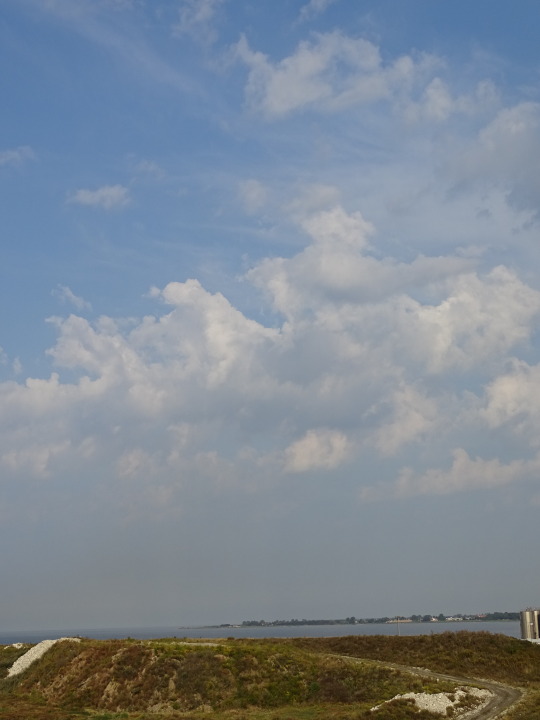
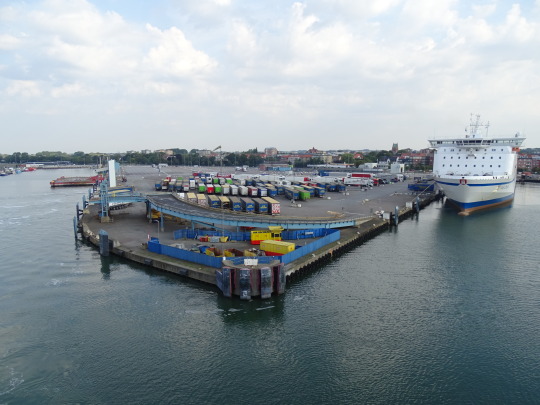

Clouds (No. 389)
near Trelleborg, Sweden (five pics)
Trelleborg, Sweden (five pics)
#Trelleborg#Skåne#Scania#landscape#evening light#blue sky#clouds#flora#nature#original photography#vacation#tourism#view#village#tree#Scandinavia#Baltic Sea#Northern Europe#Sverige#harbor#ferry#on board#line#Sweden#countryside#seascape#morning light#MS Huckleberry Finn#TT-LINE#architecture
13 notes
·
View notes
Text
Marine Bollard Market to be at Forefront by 2026
Marine bollard is a simple and cost-effective way suffice marine bollard needs and helps to safely secure vessels alongside jetties, wharves and berths in harbors and ports. Marine bollard helps control the risk of loss-of-position events such as marine bollard line failure, which can lead to failure of the riser and release of hydrocarbons. The necessary recovery plans must be in place in order to manage the loss-of-position event. Marine bollard lines and flexible riser systems have gained significance of late. Marine bollard systems are designed to last for long periods of time (generally 10 years to 30 years) in challenging environments. Every operating area faces major challenges, such as tropical cyclones, accelerated corrosion, and constant fatigue loads, for continuous operations. In order to meet these challenges, guidance regarding marine bollard design needs to be equally strong. Software packages accurately simulate marine bollard loads, components are manufactured with higher strength and fatigue capacities; and design guidance is updated to reflect new failure modes.
Read Report Overview @
https://www.transparencymarketresearch.com/marine-bollard-market.html
Tee head bollard, twin horn bollard, kidney bollards, and pillar bollards are the various types of marine bollards. Tee-head bollards (or 'Tee' bollards) are ideal for handling high line angles on multi-purpose berths. Twin horn bollards is a well-proven design, which facilitates mooring and releases two lines independently. Kidney bollards are available in a wide range of sizes and capacities to suit mooring applications from small marinas and harbor wharves. Pillar bollards are suitable for applications where tidal range variations are large. Marine bollards are employed in jetties, berths, and wharves.
Marine bollard helps in reducing the incidence and magnitude of design-related errors. It also helps in the reduction of fabrication errors. New technological innovations are emerging in order to develop cost-efficient solutions for marine bollards. Marine bollard systems fail when they face conditions outside of their intended design envelope. This is one of the limitations of marine bollard. Safety concerns are also restraints of marine bollard systems. Extreme weather conditions such as storms and heavy tides pose a threat to marine bollard systems. Budgetary and technical constraints affect the strategy choose to ensure that the reliability of marine bollard systems stays uncompromised.
Request to view Sample Report:
https://www.transparencymarketresearch.com/sample/sample.php?flag=B&rep_id=52545
Countries in Asia Pacific such as India, China, Singapore, and Japan are emerging regions for marine bollard market, due to the growth in industrialization and rise in seaborne trade activities in these countries. This has driven the investment in marine locomotives. Countries in Europe such as the Netherlands, the U.K., France, Germany, and Norway are witnessing high demand for marine bollard market owing to the eco-friendly energy norms imposed by governments of the respective countries. Demand for marine bollard is increasing significantly in North America. The International Marine Contractors Association has initiated development of its own recommended practice (RP) for marine bollard. Countries in Latin America and Africa are recovering from the economic slowdown. Thus, the marine bollard market in these countries is likely to expand at a sluggish pace during the forecast period. Countries in Middle East such as Saudi Arabia, Kuwait, Qatar, and U.A.E are investing heavily in maritime activities to promote tourism and enhance maritime security. It ultimately propels the demand for marine bollard in the region.
Request For Custom Research @
https://www.transparencymarketresearch.com/sample/sample.php?flag=CR&rep_id=52545
Key players operating in the global marine bollard market are Trelleborg, Prosertek, ESC Group, Automoor, TEKMARINE, Eurotech Benelux B.V., and Nautica Expo.
0 notes
Text
The Final, Terrible Voyage of the Nautilus
On May 3, 2 008, a sunny Saturday in Copenhagen, a mob amassed along a dock to watch a 58 -foot submarine be lowered into the sea. Part art project, component engineering achievement, the submarine weighed 40 tons and had been has been established by volunteers at minimal cost from donated iron and other portions. The spectators cheered as the submarine swam for the first time. Peter Madsen, the designer of the vessel and the organisers of the day’s event, climbed into the hatch, smiling in a white skipper’s hat, before the submarine motored into the water.
Madsen christened the ship the UC3 Nautilus , after the fictional submarine in Twenty Thousand Leagues Under the Sea . Jules Verne’s antihero Captain Nemo was a figure who lived outside social statutes, sailing the seven seas in search of total freedom. Unlike Nemo, Madsen had stayed close to home in Denmark, but he had devoted his life to constructing audacious vehicles of his own design, ones that might venture high above the atmosphere or down into the depths of the ocean.
Shortly after the launch of the Nautilus , Madsen started another undertaking. He and a former NASA contractor named Kristian von Bengtson cofounded a company called Copenhagen Suborbitals. Their programme was to launch the first manned built-from-scratch rocket. The two set up shop on Refshaleoen, a zone of the city that extends into Copenhagen’s harbor and once had been the heart of Denmark’s shipping empire. That industry’s wane “d left” empty warehouses and mills, which had been reclaimed by artists, engineers, and other creative characters. Madsen and von Bengtson were among them, occupying a hangar, and financing Copenhagen Suborbitals with crowdfunded donations. It was, von Bengtson wrote in 2011 on a WIRED blog he started that year about the rocket build, “the ultimate DIY project.”
The programmes made Madsen a kind of antiestablishment celebrity in Denmark. “You had a sense that he was doing something different. It was something bigger. It was something worth being part of, ” Robert Fox, a filmmaker who made a 2009 documentary about Madsen called My Private Submarine , told me. A biography of Madsen was published some years later. Madsen parlayed this fame into speaking engagements.
In 2016, another filmmaker released a documentary called Amateurs in Space , about Madsen and von Bengtson and their efforts to build a rocket. To watch the cinema is to see the men’s relationship fall apart. In June 2014, Madsen opened a new workshop of his own, Rocket Madsen Space Lab, in a hangar across the paved lot from Copenhagen Suborbitals.
In March 2017, a freelance columnist named Kim Wall learned about the rival rocket manufacturers. Wall had been raised in a Swedish township called Trelleborg, simply 40 miles from Copenhagen. She had left home for schooling in Malmo, Sweden, then London, Paris, and eventually New York, which she was calling home for a while. She was in Refshaleoen visiting her collaborator, Ole Stobbe, a Danish designer who had just moved there. The two were walking around one afternoon, past the vestigial houses of the old shipyards, when they came in all the regions of the rocket-building workshops.
In the four years Wall had been a reporter, she had traveled to Haiti to write about practitioners of voodoo; to Sri Lanka to document the tourism on former battlefields of the long civil war; to Cuba to follow the underground network of people delivering TV proves and internet culture. Wall was fascinated with what she called “the undercurrents of rebellion.” Here was just such a tale simply minutes from where she was staying.
Wall reached out to various publications, and had email exchanges with editors at WIRED, working towards getting an assignment to write about the rocket builders. She and Stobbe had also decided to move to Beijing together, and their departure date was approaching. She had interviewed one of the builders at Copenhagen Suborbitals and was hoping to speak with Madsen, but she hadn’t will reach him. She had only a few periods left in town.
Wall got the text she had been waiting for: Madsen was inviting her to tea.
On August 10, a Thursday, Wall and Stobbe were preparing to hurl a goodbye party. In the late afternoon, just as they were setting up for a barbecue on the quay along the water in Refshaleoen, Wall got the text she had been waiting for: Madsen was inviting her for tea at his workshop. Madsen’s hangar was not far, so she set off. About half an hour later, she returned to let Stobbe know that Madsen had submit a report to take her out on his submarine. She decided to forgoes her own goodbye party for the interview. She asked Stobbe if he wanted to come. Stobbe was “insanely close to saying yes, ” he told me, had it not been for the group he had assembled. Because she was going out to sea, Stobbe committed Wall a bigger kiss than he would have had she gone out for, say, ice or lemons. Wall promised to be back in a few hours.
Just before boarding the submarine around 7 pm, Wall texted Stobbe a photo of the Nautilus . A little later, she mailed a photo of windmills in the water, and then another of herself at the steering wheel. A while afterwards, Stobbe was tending to a quayside burn when a friend told him to look up. He watched the fix sunlight and Wall aboard the submarine in the distance, waving toward him.
By most public accounts, Madsen was a charismatic rebel. He had a weathered face with the prominent features of a plaything troll. His habitual uniform was coveralls and hiking boots. Fox, the filmmaker, calls him a “modern-day Clumsy Hans, ” for the apparently dimwitted suitor in the Hans Christian Andersen fairy-tale who wins the princess’s favor over his more intelligent brethren. Wall was in the early stages of her reporting, and she would not be aware of this much more about Madsen than what had already been published. It was only later, after everything that happened, that the details of his private life would become important.
Refshaleoen had once been the heart of Denmark’s shipping empire.
Mustafah Abdulaziz
Madsen was born in 1971 and grew up in a small town south of Copenhagen. His mom, Annie, was more than three decades younger than Madsen’s father, Carl–a pub owner. She had three boys from two previous wedlocks, and the union with Carl did not last long. Madsen was six when his mothers split up. Annie moved out with her other sons while Madsen remained with his aging father.
According to Madsen’s biography, writes to Thomas Djursing, Carl was a brutal boy who beat his stepsons, though not Madsen. It was Carl who stoked his son’s fascination with rockets, telling him , among other things, about a human who would become a hero to Madsen: Wernher von Braun, the Nazi aerospace engineer who later came to the US and helped develop the Apollo missions. Carl died when Madsen was 18, and for the next few years, Madsen ricocheted around, starting several degrees and apprenticeships–in welding, refrigeration, and engineering–before falling out of each.
As a adolescent, Madsen detected the Danish Amateur Rocket Club but was eventually kicked out because he wanted to use fuels that others in the group seemed weren’t safe. He invested his twenties and thirties organizing their own lives around the building of submarines and rockets. He often slept at the workshop where he built things.
Madsen’s obsession with submarines and rockets was all-consuming, but not to the exclusion of sex. I get in contact with Camilla Ledegaard Svendsen, an age-old friend of his, through Facebook. She told me that Madsen became a regular at sex fetish parties. These were a place of community, she said, “where everyone was relaxed about everything, including their bodies, ” and where women felt safe. He also availed himself of Travelgirls.com, a website that advertises meeting “thousands of adventurous girls who want to travel.” Deirdre King, who was Madsen’s close friend for more than a decade, told me he could be doting. “I broke both of my hands once, and Peter came by every day for two months and brushed my hair, ” she told me. “He is a man who loves women.”
Fox, who spent 100 periods with Madsen and his crew while attaining My Private Submarine , said that “women discovered him fascinating” and that the Nautilus sometimes played important roles in his seduction strategies. “’This is my submarine. You want to see my submarine? ’ He kind of used to draw that off a lot, ” Fox recalled.
After he split from Copenhagen Suborbitals, Madsen moved his rocket-making workshop simply across the lot.
Mustafah Abdulaziz
The goodbye party continued into the night that Thursday in August and finally moved to a nearby bar. When Wall still had not returned, Stobbe began to worry. The couple was supposed to leave for a wedding early in the morning, and it was unlike Wall to not stay in touch. Stobbe waited for his partner by the wharf. Then he went back to his room, tried to sleep, get up, grabbed his bicycle, and ride around the island in search of her. Around 1:45 am he called the police; a half hour later he called the navy. Wall was missing.
Just before 4 am, the police were notified of a possible accident by the local maritime rescue middle. Soon after, helicopters and ships began searching the water around Copenhagen. At 10:30 am, the Nautilus was spotted near a lighthouse in Koge Bay, near a desolate stretch of coastline southwest of Refshaleoen. According to a local news report, at 11 am a man out on his craft helping with the search discover Madsen in the submarine tower. He read Madsen go down the hatch, then reemerge as the sub began to sink.
Madsen then began swimming toward a nearby motor craft, where he was pulled out and turned back to land. By now, newsrooms had learned about the search for a missing submarine. Upon Madsen’s rescue, reporters headed to the dock. When he stepped ashore, a reporter called out to Madsen, asking if everything was OK. Madsen turned around and committed the reporter a thumbs-up. He said he was fine but sad because his Nautilus had dropped. There had been a defect on the ballast tank, he said.
Related Stories
Sarah Scoles
What Happens Now? Learns of Sexual Harassment Can Show the Way
Julia Angwin
How Journalists Fought Back Against Crippling Email Bombs
Issie Lapowsky
The Year Women Reclaimed the Web
Stobbe was at the dock where the press had amassed that morning as Madsen devoted his thumbs-up. He knew that something was off and braced for the worst. Still, he wasn’t prepared for what was to come. Afterwards that day the police put under a statement saying that Madsen had told them that he had dropped off Wall on the tip-off of small island developing. The police clearly did not believe him; they arrested him and accused him with involuntary manslaughter “for having killed in an unknown route and in an unknown place Kim Isabel Fredrika Wall of Sweden sometime after Thursday 5 pm. ”
The next day, a Saturday, Madsen appeared in courtroom at a closed-door conference. He hadn’t dropped Wall off on the island; she died in road traffic accidents onboard the submarine, he said. His tale was changing. A hatch had fallen on her psyche, and he panicked, he would claim. He said he dragged her body out of the submarine by a rope and “buried her at sea.”
On August 21, a cyclist journeying along on Amager Island , not far from where the submarine drop, came across a torso that had washed ashore. The next day, DNA analysis confirmed that the torso is accountable to Wall. On September 5, a court approved the prosecutor’s request to change the charge against Madsen to manslaughter. An autopsy afterwards revealed that she had been stabbed 15 hours in and around her vagina. Then, one month afterwards, divers procured her psyche, attire, and a knife in plastic bags, in the seas not far from where her torso was discovered. They also detected both her legs, tied to pieces of metal. Despite these breakthroughs, Madsen stayed to his tale: Wall had made her chief and succumbed, and he disposed of her body, but he denied killing her or dismembering her. Even after divers acquired a watch that might have been used to dismember Wall’s body, even after the police searched Madsen’s computer and discovered videos that appeared to show females being strangled, beheaded, and tortured–he stay to his story.
Kim Wall and I were both freelance novelists, both young and female, both reporting from abroad. Our relationship began after we followed one another on Instagram and Facebook. Then, a year or so later, in 2016 we found ourselves in New York. We invested most of the summer sitting across from each other in a glum coffee shop in Williamsburg, working on our laptops. We didn’t yet know where reporting objective and living began. We ensure in one another a companion, but likewise a guide. She was my friend and likewise the closest thing I had to a colleague. When I left for Afghanistan that autumn and she for Denmark and later Cuba, we kept in touch by text, talking each week if not more often.
When I learned that Kim had disappeared, my instinct was to find out everything I could about what happened to her. I could say that I was trying to control grief by examining the source of that sorenes, but that would be reasoning in hindsight. All I knew was that it was painful to think about Kim, and it pained me simply a little less to try to report about Madsen.
In the weeks and then months following Kim’s death, I read local news stories, watched the documentaries about Madsen, and scrolled the posts on the blog he maintained on an engineering website. I went on Madsen’s Facebook page and mailed friend requests to every one of his contacts there. I spoke to dozens of people are attached to Madsen–family members, buffs, collaborators, fans, and childhood friends, many of whom would not let their names to be used for this story. I spoke with lawyers, a forensic pathologist, and an oceanographer. In late September I flew to Copenhagen. I met with members of the police division leading the investigation, but they did not uncover much and did not want to speak on the record. I objective up committing them a statement. They asked about my friendship with Kim, and I told them what kind of person she was and why it wasn’t surprising that, as a columnist, she would have chosen to go with Madsen on the submarine.
On my first afternoon in Copenhagen, I met with Jens Falkenberg at a restaurant on Dag Hammarskjolds Alle, in an affluent part of township. Falkenberg is a 58 -year-old roof salesman. He first heard about Madsen years ago, when he saw a segment about him on television and, by coincidence, gratified him the next day at a diving store. He started volunteering at his workshop and helped build the Nautilus . He told me that the police had been calling, asking about a ascertain that was missing from Madsen’s rocket workshop.
If something did not please Madsen, “he would behave like small children who just lost his toy.”
Falkenberg was like many of the others who volunteered with Madsen, who called himself “a maker of extreme machines.” They expended their weekdays in regular undertakings but were weekend builders. They wanted the feeling of community the workshop made them. At the center of their alternating cosmo where boys constructed submarines and rockets was Madsen himself.
Some volunteers “was talkin about a” Madsen as a generous spirit, the various kinds of guy who would invite a pal who was feeling down “to take part in his little adventures as a means of applauding him up, ” as a friend named Lars put it.
Others reexamined old incidents and behaviours. Madsen could sway between rage and euphoria. One volunteer at Copenhagen Suborbitals told me that if something did not please Madsen, “he would behave like small children who just lost his toy or plummeted his ice cream or something.” When his feeling turned, “most people would know what was going to happen, so they would stay away from him before material started flying.” Volunteers said Madsen threw hammers, screwdrivers, and other tools. One volunteer, who asked to be identified by his initials, S. W ., helped build the Nautilus . He recalled how Madsen would go from being supportive to “pensive, jubilant, irritating, and sarcastic.”
“It’s hard for us to understand what drives a madman, because we are not mad, ” Falkenberg told me. He then described a recurring gag: Madsen would pretend to be a violent Nazi and would mime reaching Falkenberg, saying “Should I punch you in the kidneys? ” or Madsen might joke: “What if I inject battery acid into your veins? ”
There was also a lot of joking around about Nazis in the workshop. Crewmembers called each other by Nazi-inspired names. Madsen was called Kaleun, for Kapitanleutnant, a nod to the 1981 film Das Boot , about a fictional German U-boat unit during World War II, Falkenberg said. When they went out in the sub, the crew spoke German, reciting lines from the film.
Madsen’s fascination with space and rockets and technological sciences could hoodwink you into thinking he was a man of the future; you are able miss the fact that his obsession was rooted in nostalgia. He was enamored with the early Apollo missions in American space exploration. The venerate he held for the Third Reich was hard to detect as it was framed as irreverence, but it was there. “Some of the behavior the Nazi regime worked, they did horrible things and they should be executed and everything. But some of the things they did, it ran, ” the former workshop volunteer told me. “They built the biggest military machine in just four years. They constructed it virtually out of nothing.”
Building something out of nothing was central to Madsen’s philosophy, as was his sentiment that he should be able to play by his own rules and control his own destiny. He seemed down on people for being cautious. He talked about wanting “to be free from authorities” in attaining his submarines. After he left Copenhagen Suborbitals, he continued a blog about the progress at Rocket Madsen Space Lab. In one enter from 2015 he described his team as people who “all know that they are taking part in a Peter Madsen project, just like they would do if it was a von Trier movie … the unqualified impression that Madsens crasy[ sic] dreams tend to become reality … induces these people invest period and money.”
Windmills on the water.
Mustafah Abdulaziz
I had been in Copenhagen a week when I moved looking for a woman I knew did not want to talk to me. She was a friend and recent sexual collaborator of Madsen’s. She lived in a converted building in Refshaleoen. One afternoon I walked through its vast hallways until I managed to find her chamber. I knocked on her doorway, and she let me in. I had twisted my ankle on the way over and was limping. She let me sit on her carpet and keep my injured foot elevated while she ate toast. Her eyes seemed heavy with sleep.
We ended up spending the rest of the working day together. She missed a concert; I skipped an appointment. We smoked Bahman cigarettes, an Iranian brand I had brought from Afghanistan. We boozed home-brewed kombucha. Music filtered in from another studio down the dorm, filling the occasional stillnes between us.
Like others I spoke with, she said she was enormously angry at Madsen and felt guilty for what she believed he had done. Her ache about Kim’s death seemed deep and genuine. And like others, she was reaching back into her remembrance of every exchange she had with him in search of clues that might explain this misfortune. She told me that she had either considered or talked to Madsen nearly every day in the weeks leading up to Kim’s death. Then she told me about a particular exchange that was still bothering her.
Wall was early in her job but had already reported narratives from Cuba, Haiti, and the Marshall Islands( above) in 2015.
Courtesy of Jan Hendrik Hinzel
Some periods before Kim stepped onto the Nautilus , the woman and Madsen were exchanging notes via iMessage. “It was a joke, ” she said, pulling out her phone and scrolling through the white and blue text. Like many people I met in Refshaleoen, this woman was typically resided with an art project of one kind or the other. “Shes been” be very difficult finishing a video, and she’d asked Madsen to motivate her with a threat. The dialogue began as a casual sexual exchange but speedily intensified. She read the texts to me, translating into English as she went.
“He says he has a murder plan ready in the submarine, and I tell him I am not afraid, you have to be more threatening. He talks about the tools he wants to use, and I say,’ Oh it’s not threatening.’ ” The scenario darkened to inviting a friend to the submarine, where they would suddenly change the feeling and begin cutting her up. At the time, the woman didn’t give the exchange much imagine; it was not something she took seriously. After a letup in the backward and forward, she responded by sending him a video of ponies. The minute passed. The police now have the texts.
Kim and I often “was talkin about a” the challenges of reporting while being young, while being a woman. Harassment, come-ons, and our panic of not being tough enough were perennial concerns. This is particularly true on the road leading. During a reporting trip-up to Cuba in 2016, Kim texted me to say that as a strategy against unrelenting harassment, she had devised a “fictional NYC fiance.” The incongruity of the go-to deflecting move being to proclaim attachment to another man was not lost on us.
Lately I have been thinking about a question Kim posed in a series of texts last spring: 3/14/ 17, 7:43 am: Kim Wall : strong> i only have questions 3/14/ 17, 7:43 am: Kim Wall : strong> about organization as a woman 3/14/ 17, 7:43 am: Kim Wall : strong> and if we will ever be free , no matter what we do 3/14/ 17, 7:43 am: Kim Wall : strong>( leaning towards no)
In the working day after she disappeared, I hear people ask questions that betrayed a misunderstanding about reporting–couldn’t she have done the interview over the phone ?– and casual sexism–why was she there alone so late? On nighttimes when I couldn’t sleep, I would end up on internet chat room where specific comments parts filled me with fury: “She is a woman–how could she go alone with a boy she does not know? ” And: “She had skirt and pantyhose–how could she egg on a poor uncle in that way.”
In Afghanistan, where I worked mainly with men, I never wanted to show any sign of weakness or panic. In reporting this story, my editor attained me promise that I wouldn’t set myself in harm’s style. But much of the submission of reports is just that–routinely putting yourself in uncomfortable points. In the four months I spent on this story, I did things that in other circumstances might have seemed foolish. I went on long drives at night with sources. I satisfied strangers on their doorsteps and entered their homes. In stepping onto that submarine, Kim was doing what any reporter onto a good story would have been able to done.
My love for Kim has turned into devotion for her parents and for Ole. I’ve invested time with them in Copenhagen, Trelleborg, and New York when they came for a commemoration for Kim; it was held at Columbia University, where she had received her master’s degrees in journalism and international affairs. We talk online and discuss the fund we are setting up in her name. I want to alleviate their suffering, but I also know that the one thing they genuinely crave is Kim.( They did not wish to be interviewed for this article, and I understood .)
Ole and I speak on the phone, to talk about heartbreak, and what is to be done about it. He is still moving to China. Movement is good, he says.
Wall and Stobbe stayed in a converted building in Refshaleoen.
Mustafah Abdulaziz
On October 30, the Copenhagen police reported that Madsen had changed his account of that night in August yet again; he said Kim might have died from carbon monoxide gas poisoning. He likewise admitted to dismembering her body. Three a few weeks later, the police detected an arm in Koge Bay, weighed down with pipes. Eight periods after that, they found another limb. Madsen’s lawyer, Betina Hald Engmark, declined to comment for this story.
I wrote Madsen two letters at Vestre Prison in Copenhagen, where he was being held before trial. I FedExed the first and dropped off the second in a mailbox near the prison. I told him who I was, who Kim had been, my sadness over losing her, and my wish that he would tell me what happened. One afternoon in January, several months after I’d returned to New York, I went to pick up my mail and acquired an envelope with no return address. It was postmarked from Denmark on December 6, 2017, but that didn’t register until after I’d opened it and started scanning the neat, hand-written pages. It was only when I got to the word “submarine” that I realized Madsen had written to me from his detention cell. I remember telling myself to keep breathing as I tried to fold the pages back into the envelope. I did not succeed. The envelope was small-scale and thin and rent in my hands.
When I ultimately forced myself to look at the letters–there were three, dated in September and November–I was struck by their terrifying cliche. He spoke patently about the boredom of prison–he had few visitors and few pastimes besides penning. He described recognizing Terminator 2 in prison and identifying with the specific characteristics played by Linda Hamilton. He explained what he had access to( paper and pencil) and what he didn’t providing access to( nearly everything else ). He also wrote about Kim. He wrote that he thought about Kim every day and that they are able to “feel her feeling somehow.” There was a disturbing friendship to his words, as if he were writing to an age-old friend. He flattered my writing style and extended an invitation to visit. He asked me, “What are you? An explainer trying to understand? A terminator sent to terminate me? … Without exception–whatever you are–you are welcome, I am all yours.” He aimed one of the letters by saying “I will try to get this letter out to you as soon as is practicable, and hope that you will stay in touch as things get easyer[ sic ]. ”
On January 16, the police released the following statement announcing that Madsen was being indicted for homicide that “took place with prior plan and preparation, ” and likewise charged him with “sexual relations other than intercourse of a particularly dangerous nature, as well as for dismemberment.” A week subsequently, the full indictment provided more excruciating details: Madsen had brought onboard “a understood, bayonet, sharpened screwdrivers, straps, zip ties, and pipes.” Madsen had bound, thump, and stabbed Kim before killing her, possibly by choking or cutting her throat, the indictment said. Madsen’s lawyer told The New York Times that she was “puzzled” by the indictment. The lawsuit is scheduled to go to trial on March 8, with a judgment anticipated in April. In between is March 23, who had allegedly been Kim’s 31 st birthday.
“What are you? An explainer trying to understand? A terminator sent to terminate me? ”
The case has been deeply unsettling to people in Denmark, a country of five. 7 million people where there were only 54 reported homicides last year. It is hard for Danes to fathom the gruesome discoveries and to imagine that someone as well-known as Madsen could be responsible for them. In December, the Danish publisher Saxo withdrew the first book in a true-crime series about the example, written by Djursing, after it comes down under criticism.
Before my trip to Denmark, I talked on the phone with a humankind who had worked with Madsen off and on for nine years. He was in shock. But he likewise allowed for the possibility of setting up unseen perversion. “Some are walking around with a fantasy like this for perhaps 10 times, ” he said, “and one day they will do this thing.” Madsen had expended his adulthood pushing against the bounds of society, of reason, of the present, of gravitation. Did he think he could get away with committing the ultimate act of brutality? The trial may offer some answers.
On one of my last day in Copenhagen, I returned to Refshaleoen. I stopped by a eatery to ask directions to the building where Kim and Ole had lived. The line cook didn’t know the building, so I asked if he knew where the reporter who had died had lived. He cut me off midsentence as I was explaining how I knew Kim and asked, “Why are you doing this? ”
I didn’t have a ready answer. I said something about how I wanted to know what had happened. But saying this out loud, to this stranger, I knew I could never actually know, could never measure the precise weight of her agony. Trying to find out what happened to Kim, in hopes of seeing meaning in the senselessness of her death, is a selfish act, designed to serve the living. It feels like an act of betrayal.
I still don’t yet know where reporting aims and living begins. All I know is that it hasn’t sink in yet that she is dead. I’m still wishing for a smaller tragedy: that she was kidnapped but will soon be rescued, or injured but healing somewhere, or lost but will find information. I wish for life. I wish for a different story.
Read More
There &# x27; s a reason women in tech are finally speaking out
Why female photographers matter now more than ever
How one correspondent use social media to get inside the minds of ISIS
May Jeong (@ mayjeong) is a novelist and a visiting intellectual at the Arthur L. Carter Journalism Institute at New York University . em>
This article is displayed in the March issue. Subscribe now . em>
Additional reporting by Andrea Powell
Related Video
Culture
How a Virtual Reality Journalist Takes Viewers Inside Stories
At Nonny de la Pena’s Los Angeles-based Emblematic Group real tales, from melting glaciers to solitary confinement, are construct in full virtual reality.
Read more: https :// www.wired.com/ story/ final-terrible-voyage-nautilus /~ ATAGEND
from https://bestmovies.fun/2018/02/17/the-final-terrible-voyage-of-the-nautilus/
1 note
·
View note
Photo

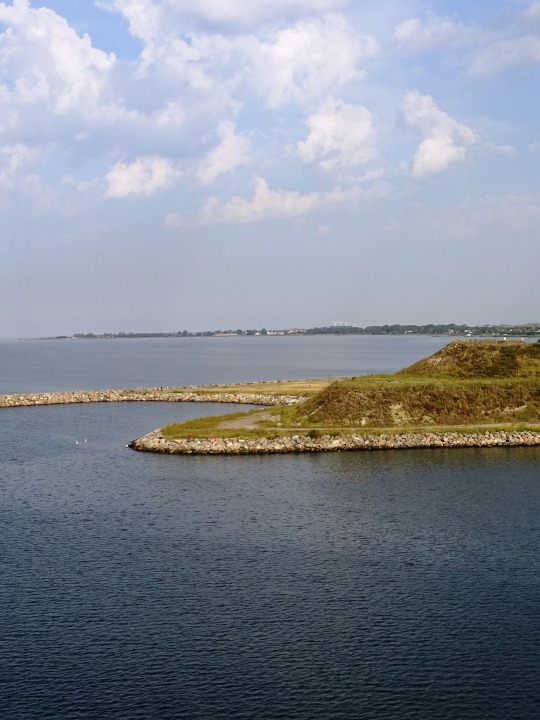




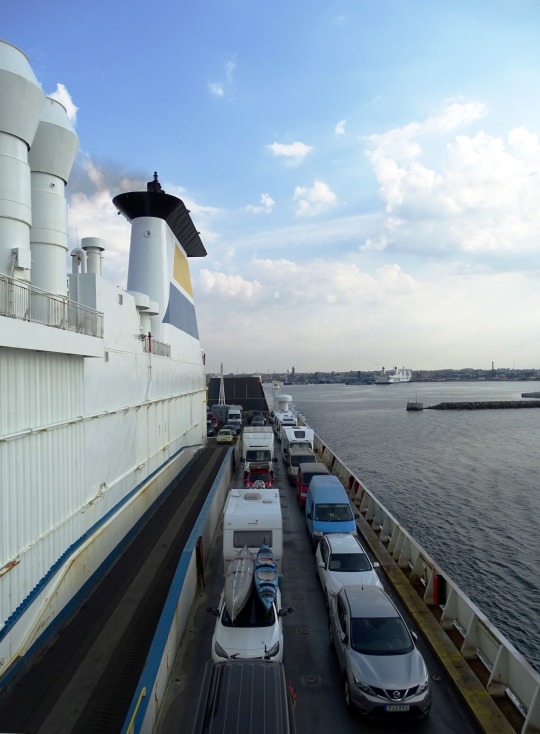
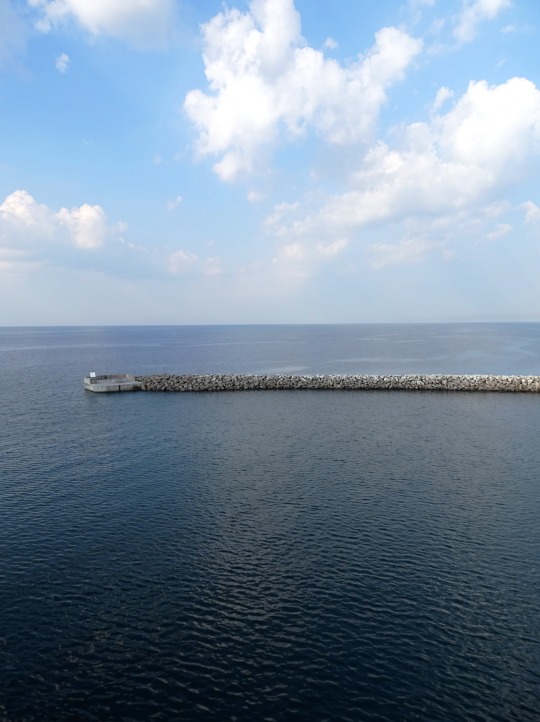
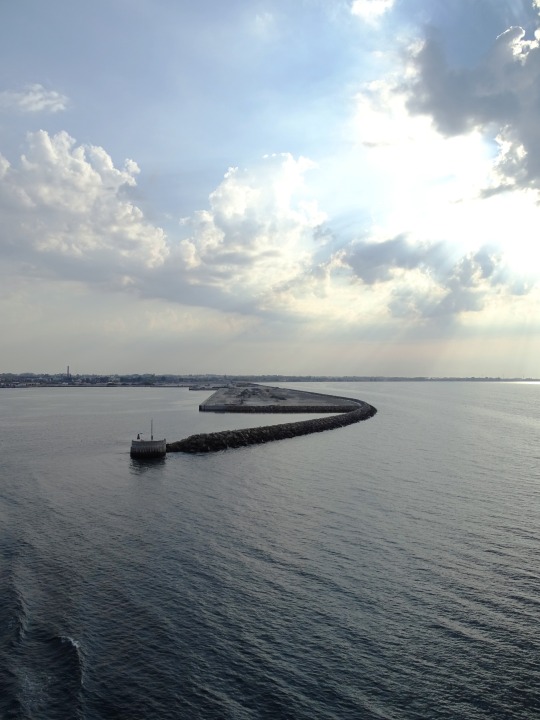
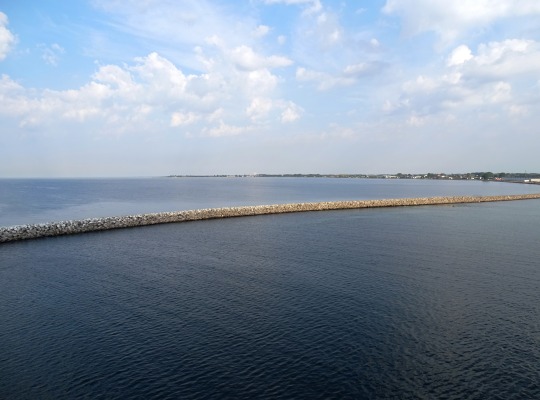
Clouds (No. 390)
Trelleborg, Sweden
#Trelleborg#Scania#Skåne#harbor#travel#Baltic Sea#morning light#Southern Sweden#coast#on board#ferry#original photography#summer 2020#vacation#seascape#sky#clouds#Sverige#Scandinavia#Sweden#Northern Europe#MS Huckleberry Finn#ship#TT-Line#car#cityscape#Ostsee#on my way to Germany#en route to Germany
2 notes
·
View notes
Photo










En Route to Germany (No. 1)
The harbour has a very strategic position, in the very far south of the Scandinavian peninsula. The first ferry connection to Germany opened in 1897. This was replaced with a train-ferry line to Saßnitz, in 1909 as a part of the line Malmö - Berlin. During the GDR era, a longer car ferry line opened to Travemünde ("modern harbour" of Lübeck), initially as line owned by the Swedish national railways (SJ), but known as TT-Line from 1962. After the fall of the Berlin Wall in 1989, several new shipping lines and routes opened. Trelleborg municipality built a joint ferry terminal for all services, known as "Kontinentbron", or "the Continental Bridge". Both Germany and Poland can be reached by ferries from the terminal. As of 2018, the following shipping lines and routes are in operation:
TT-Line
to Klaipėda (Lithuania)
to Travemünde (Germany)
to Rostock (Germany)
to Swinoujscie (Poland)
Stena Line
to Rostock (Germany)
Unity Line
to Swinoujscie (Poland)
Most of the ferry transports are lorries, and this makes Trelleborg's port the largest in Sweden in terms of goods by weight. In 2005, 11 million metric ton of goods passed through the port (along with almost 2 million passengers).
Source: Wikipedia
#Trelleborg#harbor#Scania#Skåne County#Sweden#Sverige#travel#summer 2020#original photography#TT-Line#MS Huckleberry Finn#ferry#on board#vacation#ship#car#cityscape#architecture#engineering#skyline#morning light#clouds#landmark#tourist attraction#back to Germany#Baltic Sea#Ostsee#Atlantic Ocean
1 note
·
View note
Photo
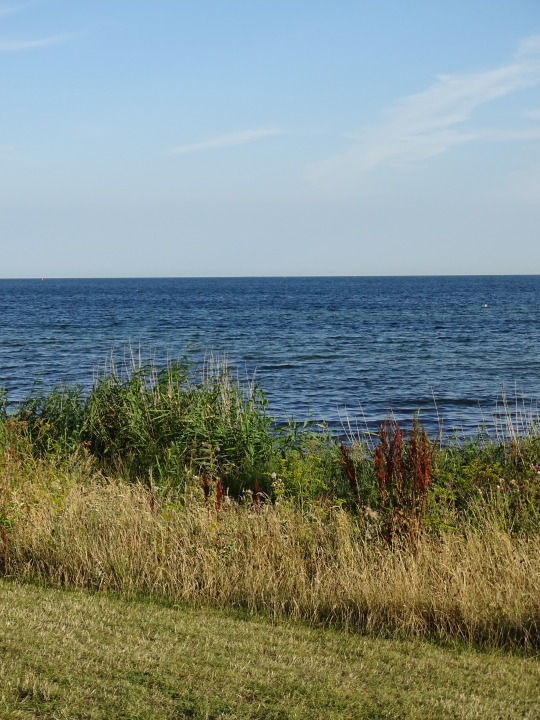
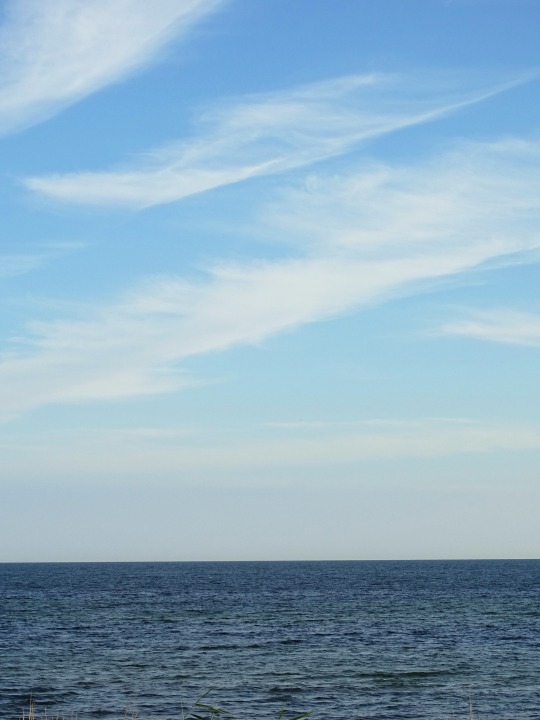


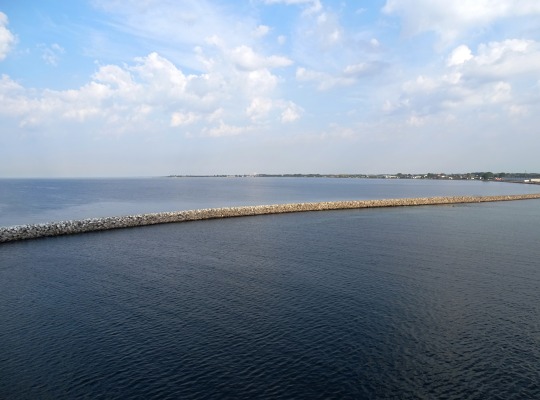





Baltic Sea, Southern Sweden (No. 3)
An arm of the North Atlantic Ocean, the Baltic Sea is enclosed by Sweden and Denmark to the west, Finland to the northeast, and the Baltic countries to the southeast.
It is about 1,600 km (990 mi) long, an average of 193 km (120 mi) wide, and an average of 55 metres (180 ft) deep. The maximum depth is 459 m (1,506 ft) which is on the Swedish side of the center. The surface area is about 349,644 km2 (134,998 sq mi) and the volume is about 20,000 km3 (4,800 cu mi). The periphery amounts to about 8,000 km (5,000 mi) of coastline.
The Baltic Sea is one of the largest brackish inland seas by area, and occupies a basin (a Zungenbecken) formed by glacial erosion during the last few ice ages.
Countries that border the sea: Denmark, Estonia, Finland, Germany, Latvia, Lithuania, Poland, Russia, Sweden.
Countries lands in the outer drainage basin: Belarus, Czech Republic, Norway, Slovakia, Ukraine.
The Baltic Sea drainage basin is roughly four times the surface area of the sea itself. About 48% of the region is forested, with Sweden and Finland containing the majority of the forest, especially around the Gulfs of Bothnia and Finland.
About 20% of the land is used for agriculture and pasture, mainly in Poland and around the edge of the Baltic Proper, in Germany, Denmark, and Sweden. About 17% of the basin is unused open land with another 8% of wetlands. Most of the latter are in the Gulfs of Bothnia and Finland.
The rest of the land is heavily populated. About 85 million people live in the Baltic drainage basin, 15 million within 10 km (6 mi) of the coast and 29 million within 50 km (31 mi) of the coast. Around 22 million live in population centers of over 250,000. 90% of these are concentrated in the 10 km (6 mi) band around the coast. Of the nations containing all or part of the basin, Poland includes 45% of the 85 million, Russia 12%, Sweden 10% and the others less than 6% each.
Source: Wikipedia
#Scania County#Skåne County#Trelleborg#landscape#seascape#harbor#Northern Europe#summer 2020#original photography#tourist attraction#coast#shore#flora#lawn#tree#Sweden#Sverige#Baltic Sea#Ostsee#Atlantic Ocean#evening light#morning light#grass
0 notes
Text
Marine Bollards Market Benefits, Forthcoming Developments by Key Players 2024
Global Marine Bollards market recent study provides an in-depth assessment of this vertical business involving main industry deliverable information, predominantly Marine Bollards market trends, size, share, current valuation, and estimates of revenues for the estimated period. The Marine Bollards industry information also analyzes and elucidates the market growth rate in the prediction timeline, encouraged by certain catalysts, a gist of which was given in this Marine Bollards research report in combination with the industry's main challenges and growth opportunities.
Get Free Sample PDF Copy of this Report @ https://www.researchkraft.com/request-sample/955067
The Marine Bollards report offers brief information about the market at the start through an overview of the situation. This includes manufacturing technology, commonly used applications, and creative methods to grow the market. The report also involves a thorough assessment of competitive outlook, trend variables, Marine Bollards industry trends, and important regional status. In addition, market growth risk factors are also noted along with the product cost, which affects the development of the Marine Bollards market during the forecast period of 2024.
Global Marine Bollards market competition by top manufacturers:
Trelleborg, Fendercare Marine, ESC, Prosertek, Walcon Marine, Australia Bollards, TEKMARINE, Max Group, Broxap, Schoellhorn-Albrecht, Zalda Technology, Katradis, Maxtech Marine Bollard, J.C. MacElroy Company, Zhiyou Marine, Sure Well
On the basis of product, we research the production:
Tee Bollards
Horn Bollards
Cleat Bollards
Kidney Bollards
Pillar Bollards
This report focuses on the status and outlook for major applications/end users:
Offshore
Coastal & Harbor
Inland Waters
Global Marine Bollards Market, Geographic Scope
Americas, United States, Canada, Mexico, Brazil, APAC, China, Japan, Korea, Southeast Asia, India, Australia, Europe, Germany, France, UK, Italy, Russia, Spain, Middle East & Africa, Egypt, South Africa, Israel, Turkey, GCC Countries
Get Discount on Purchase report: https://www.researchkraft.com/check-discount/955067
The global Marine Bollards market report offers important industry information, including valuable facts and figures, specialist views, and the recent trends worldwide. Also, the report calculates the Marine Bollards market size, the report takes into account the revenue generated from this report's sales and techniques from different application sections. The study provides comprehensive coverage of the Marine Bollards industry and major trends in the market. The research involves historical and forecast data, demand, details of implementation, price trends, and geographically leading Marine Bollards business shares. Based on application type and geography, the study divides the market size by quantity and value.
The study objectives of this report are:
To analyze global Marine Bollards status, future forecast, growth opportunity, key market and key players.
To present the Marine Bollards development in United States, Europe and China.
To profile main players strategically and evaluate their Marine Bollards growth plan and policies comprehensively.
Defining, describing and forecasting the Marine Bollards market by type of product, market and key regions.
The Marine Bollards research also elucidated extensive information of product consumption spanning numerous parts as well as the valuation obtained by these regions.
Make An Enquiry: https://www.researchkraft.com/send-an-enquiry/955067
Customization Service of the Report:
Research Kraft provides customization of Marine Bollards reports as per your need. You can customize this report to fulfill your demands. Contact our sales team to ensure you get a report that fits your needs.
Contact us:
Email: [email protected]
0 notes
Text
Trelleborg Supplies Bespoke Gasket To Protect Museum Ship In Finland
Trelleborg’s marine and infrastructure operation has supplied a specially designed Gina gasket (G110-80) to the floating dry dock which protects the renowned museum ship, Pommern, located in the Mariehamn Maritime Museum in the Åland Islands, Finland. Built in 1903, Pommern is the only four masted steel merchant barque in the world left in its original state. After sailing for over 70 years, the ship has provided the centerpiece to the museum since 1957.
Image Credit: steinias.com
Trelleborg was tasked by EE Engineering, who constructed the dry dock where the ship is now housed, to provide a purpose-built leak-free alternative to a standard D-fender. The option chosen was the Gina gasket. Only one of this type of gasket is required as opposed to several gaskets needed in the D-fender to obtain the same result as the smaller Gina gasket. In addition to this, Trelleborg also supplied its low friction, wear resistant UHMW-PE fender panels, which guide the floating dry dock door into its recess before the Gina gasket is compressed and closes off the dry dock.
Emil Engblom, CEO at EE Engineering, commented: “The Pommern is widely considered a symbol for Mariehamn and its maritime heritage. Therefore, there has been significant investment in the ship’s refurbishment and preservation. Central to that plan is the construction of a dry dock to safely and effectively moor the ship at the western harbor of Mariehamn.
“It was imperative that a manufacturer was specified that could provide a solution, with a proven track record, to successfully seal the dry dock door. Trelleborg approached the challenge head-on and proved to be a very experienced and trustworthy partner.”
Richard Hepworth, President of Trelleborg’s marine and infrastructure operation, commented: “Our custom Gina gasket provided the ideal solution as it ensured a watertight closure, greater tolerance bandwidth and low jacking force due to its various levels of hardness. It also facilitated less fixation materials on the dry dock door and offered a simple, hassle-free installation process.”
To seal the dry dock door, the Gina gasket is made from natural rubber combined with various levels of hardness to accommodate for the variation in hydrostatic pressure and is supplied as a U- frame. The fender panels were faced with Trelleborg’s ultra-high molecular weight polyethylene UHMW-PE, a first choice for this and other heavy duty applications. It combines very low friction with excellent impact strength and a wear resistance superior to that of steel.
Press Release
Report an Error
from Storage Containers https://www.marineinsight.com/shipping-news/trelleborg-supplies-bespoke-gasket-to-protect-museum-ship-in-finland/ via http://www.rssmix.com/
0 notes